Sabah, Borneo, July 2022
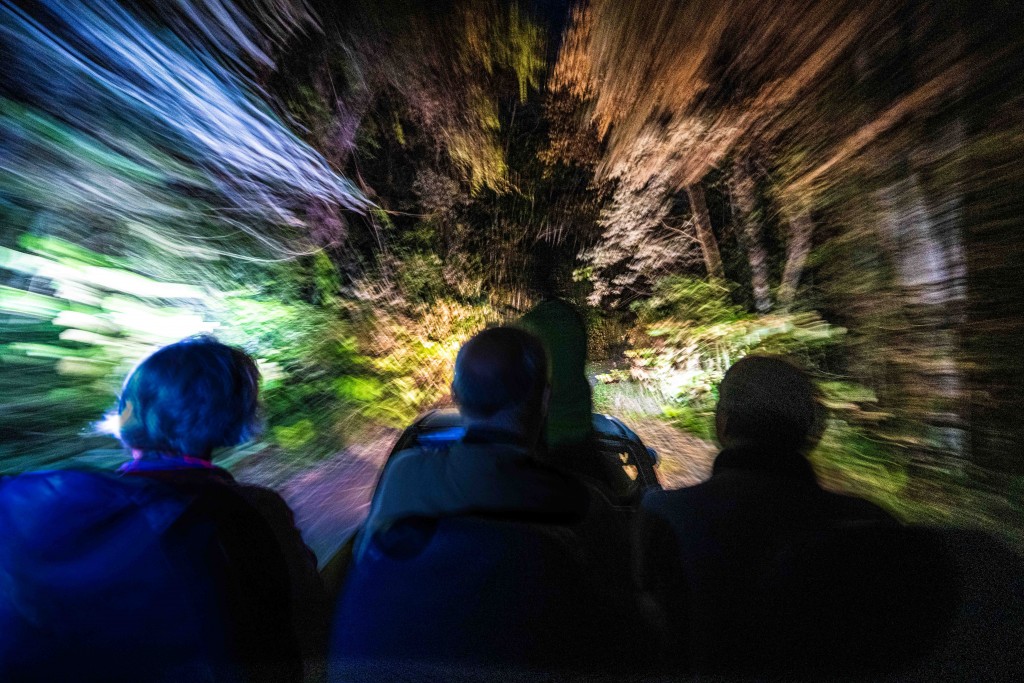
Night drive. Photo Charles Hood.
Karen Baker, Mike Gordon (guide), Jon Hall, Charles Hood, Phil Telfer, Ian Thompson, Tracey Watchurst.
Some people are guided by a set of core values. Others turn to religious beliefs or focus on doing all they can for their family or loved ones. I turn to my Top 21 Species To See List.
Before I returned to Borneo last month no fewer than four of my 21 most wanted list were easiest to find on Borneo: Sun Bear, Marbled Cat, Otter Civet and any Linsang species. And a fifth – the fabulous Tufted Ground Squirrel – is endemic. Meanwhile Clouded Leopard tops my 21 Species I To See Again list (yes I have a list for that too). So a return to Borneo was more destiny than choice.
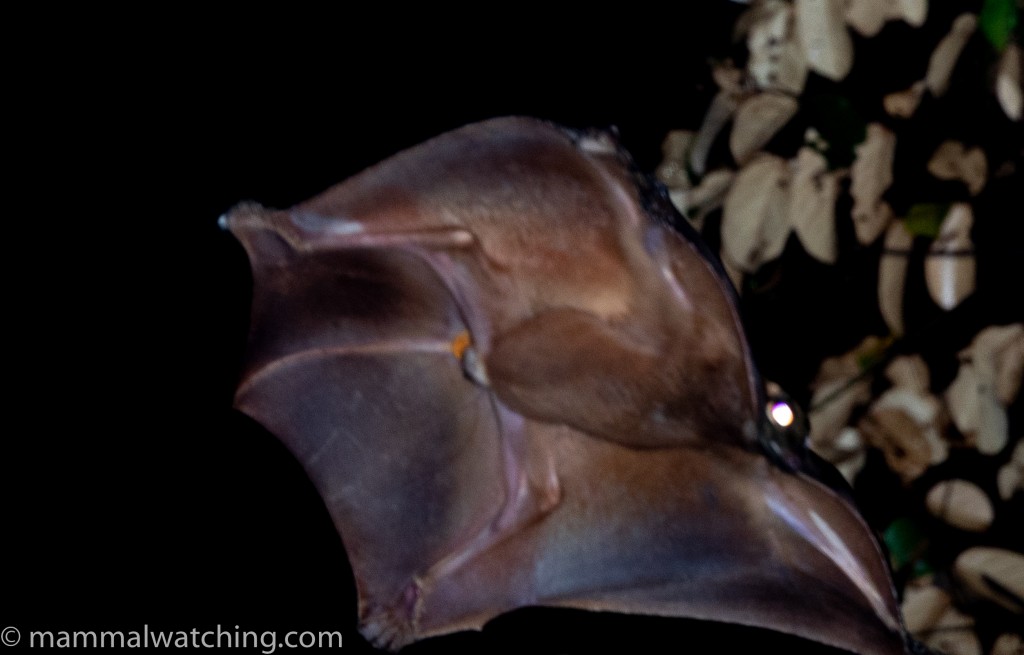
A Sunda Flying Lemur (Galeopterus variegatus) takes off in Deramakot forest.
Ian Thompson wrote an excellent account of our 2 weeks there. I wanted to add a few reflections on the three areas we visited and the mammals we saw.
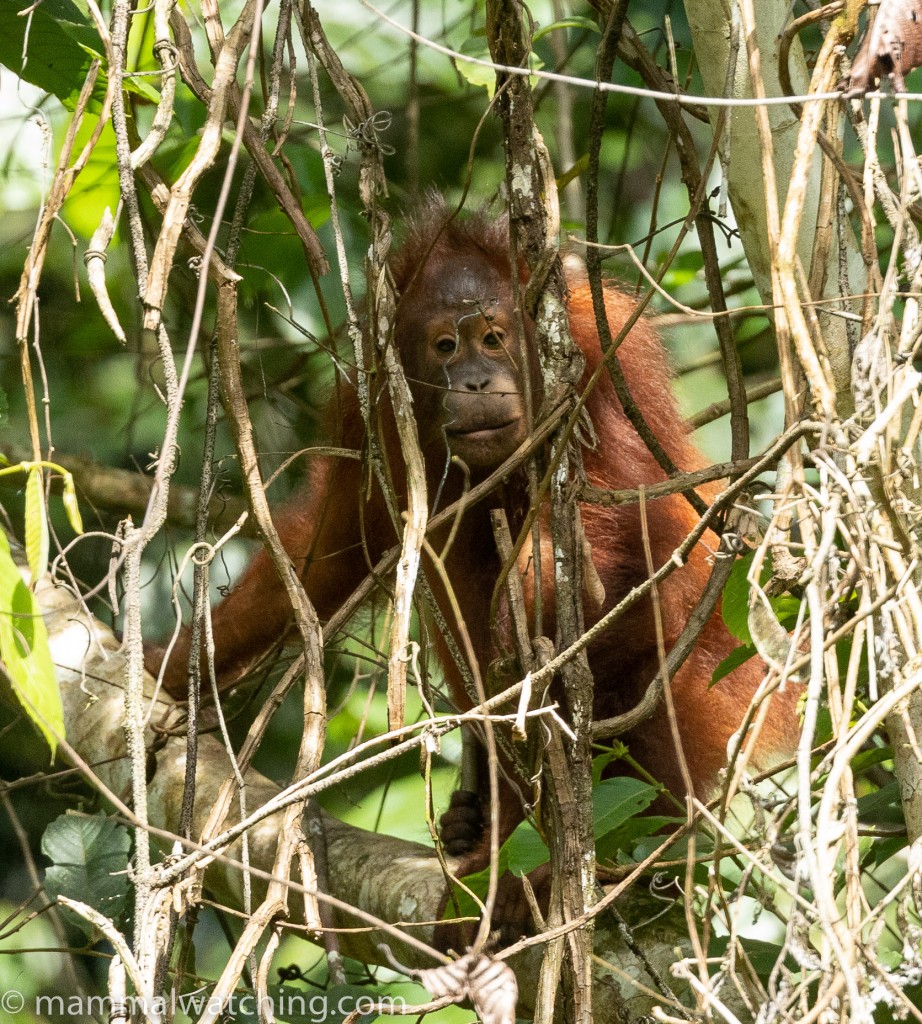
Bornean Orangutan (Pongo pygmaeus), Deramkot Forest.
Setting an Itinerary
This was my fourth trip to Borneo. Most of us had been before so I picked an itinerary focused on our key target species rather than seeing as much as possible. Any first time visitor to Borneo ought to visit the Kinabatangan River and Gomantong Caves for example.
We settled on eight nights in Deramakot Forest Reserve to focus on Clouded Leopard, Marbled Cat, Sun Bear and Otter Civet. Three nights on Mount Kinabalu to look for Banded Linsang. And two nights at the end to see if we could turn up a Tufted Ground Squirrel at Sayap Substation on Kinabalu (a long shot but worth a try).
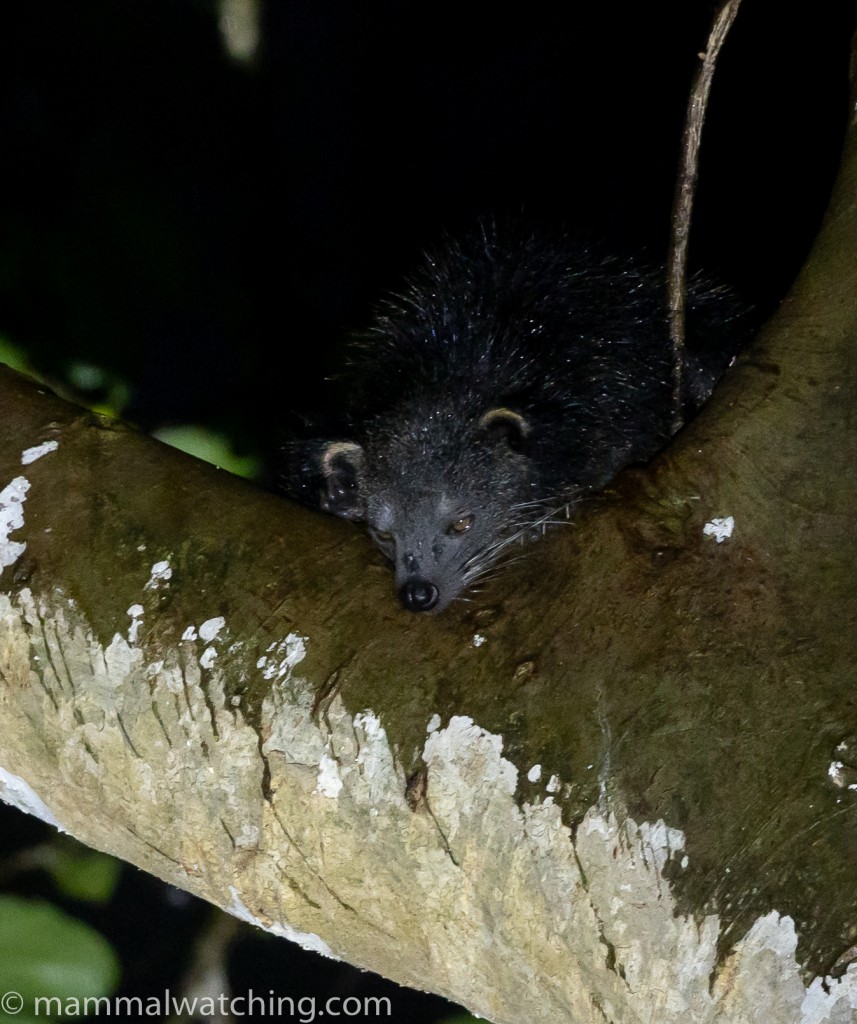
Binturong (Arctis binturong), Deramakot Forest.
One of the more difficult decisions we had to face was whether to focus our lowland rainforest time on Deramakot exclusively or also visit parts of the Danum Valley or Tabin. Though there are variations in what species you are more likely to encounter in each area I am not convinced that any one lodge or park is better or worse than any other for our target carnivores. Clouded Leopards, Marbled Cats and Sun Bears can be seen anywhere. Deramakot has several advantages over some of the other sites in that there are few restrictions for hard core mammalwatching and Mike Gordon knows it like the back of his hand.
Having said that when I go back I will likely try a few days somewhere else: it might not improve my odds for a Marbled Cat or Clouded Leopard but it might open the door to a few new species like Thick-spined Porcupine which seem uncommon in Deramakot.
Mike Gordon and Adventure Alternative Borneo
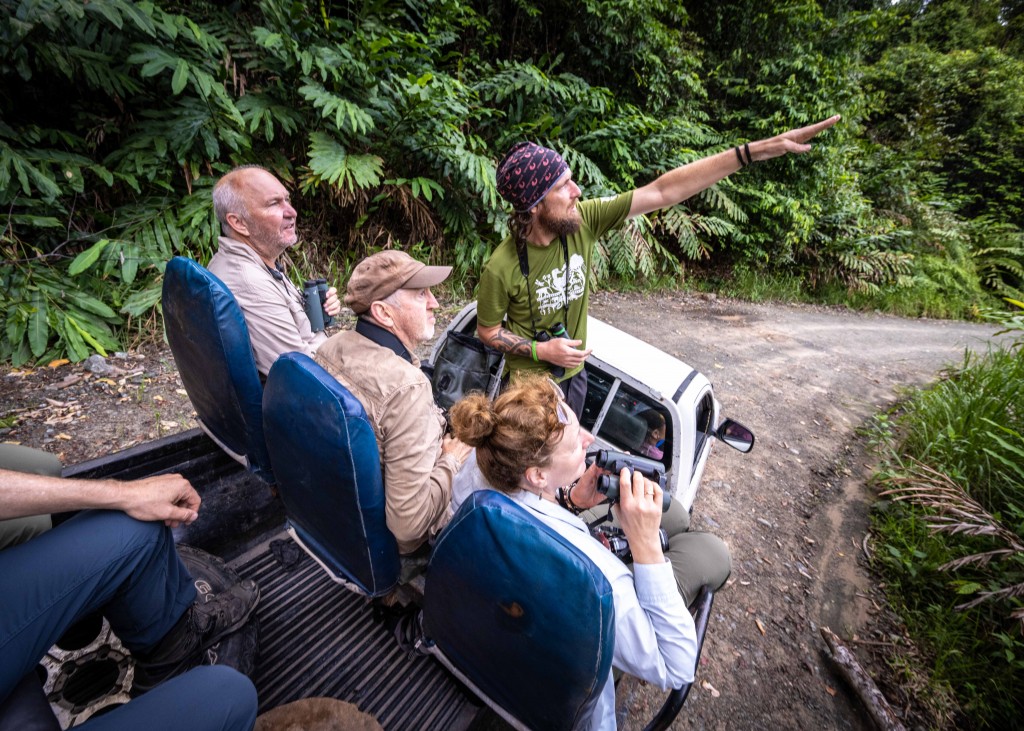
Mike Gordon (front) spotting something before the rest of us. Again. Photo Charles Hood.
We set the trip up with Adventure Alternative Borneo who put Deramakot on the mammalwatching map 8 or more years ago. They know the rest of Sabah well too, give honest advice and put an emphasis on setting up trips that are affordable. Mike Gordon is one of AAB’s guides.
Mike Gordon is a legend. I first met him back in 2015 when he was fairly new to the spotlighting game. I was impressed then by his enthusiasm and willingness to stay out all night and stay focused with seemingly superhuman powers of concentration.
Seven years later the enthusiasm and focus are as strong as ever: he pull a spotlighting all nighter and 9 hours in still be seeing roosting bats and stationary mice. But his superpowers have expanded: he is now extremely skilled in spotting and immediately identifying the wildlife of Deramakot in particular. I’m a fan of heat scopes but they are no match for Mike. On balance he was a more effective and efficient finder of interesting mammals than my thermal scope. For every one interesting species I found in my thermal scope that Mike had missed, we wasted time investigating ten sleeping birds, glowing cicadas and hot fruit. So I turned off my thermal scope and left it to Mike.
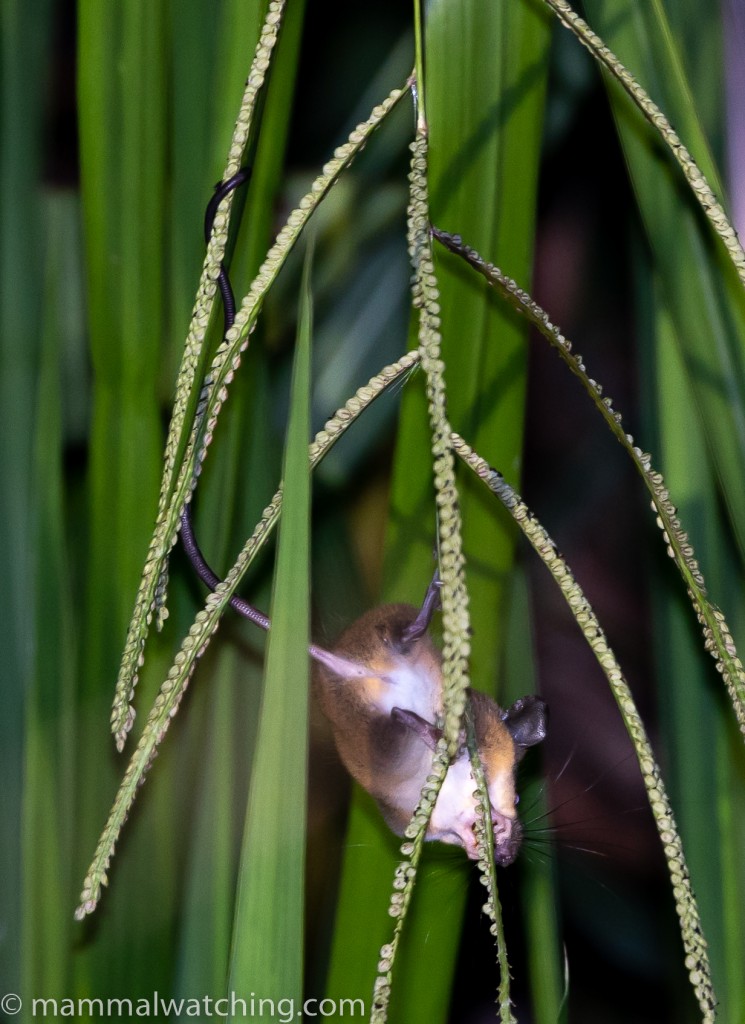
Lesser Ranee Mouse (Haeromys pusillus), Deramakot Forest.
Mike’s trademark spotlighting dance from the back of the truck is about as tough on his body as going ten rounds as a UFC fighter. He moves like a French mime clown on amphetamines. But it ensures he covers as much forest as is humanly possible while simultaneously processing whether each set of eyeshine is worth a second look or yet another flying squirrel, civet or loris. He was spot-on with every ID call he made by the way. It just took us several days to fully trust him and stop checking each squirrel for ourselves. Shame on us.
Oh and he’s also very good company with thoughtful perspectives and funny stories on life in Borneo and beyond, even if we didn’t have much time for chit chat.
Deramakot Forest Reserve
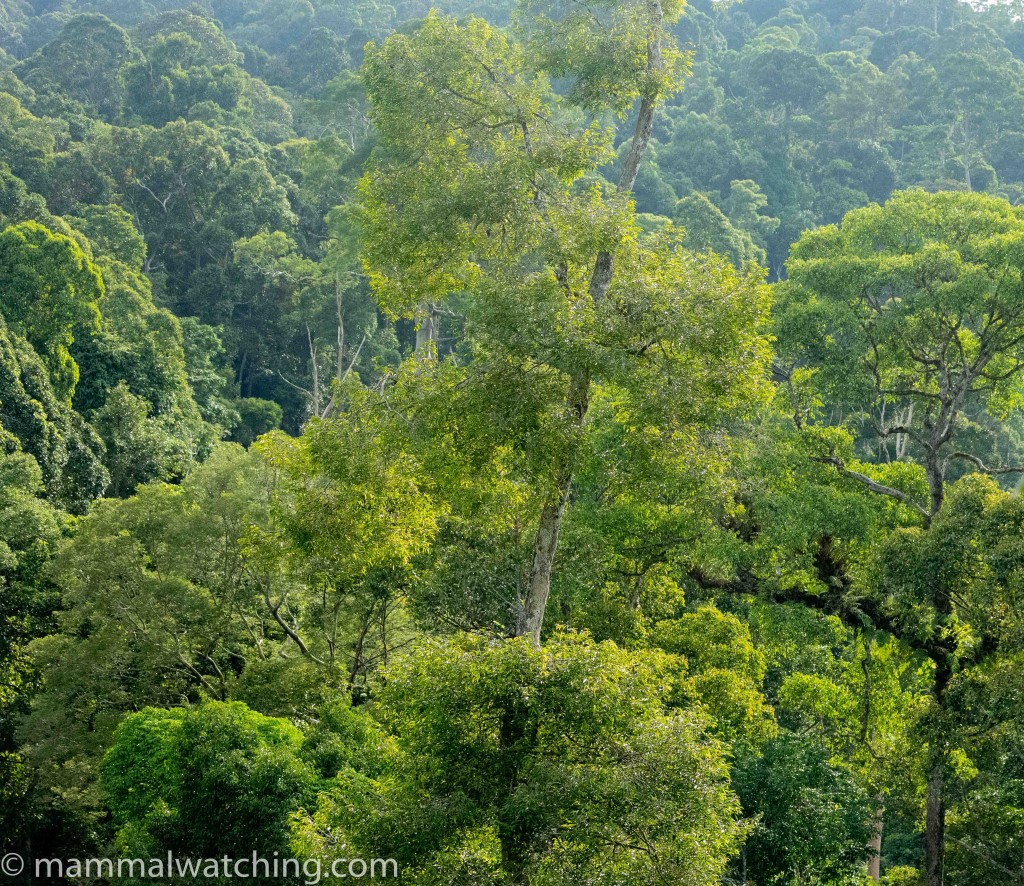
Deramakot Forest Reserve
Deramakot is a large forest reserve that takes about 4 hours to reach from the nearest airport at Sandakan. Warning: it took Malaysia Airlines three attempts to land our plane at Sandakan. The pilots blamed strong winds, though the grass along the runway wasn’t even swaying. Its been a long time since most passengers clapped when our plane landed. Even longer since I wanted to join in.
The reserve is managed as a commercial forestry operation but, according to Mike, the logging is done selectively and with great care and a myriad of rules are meticulously followed. So Sabah is proud of its example of how logging and conservation can go hand in hnd. You can barely tell which areas have been logged recently and which have not.
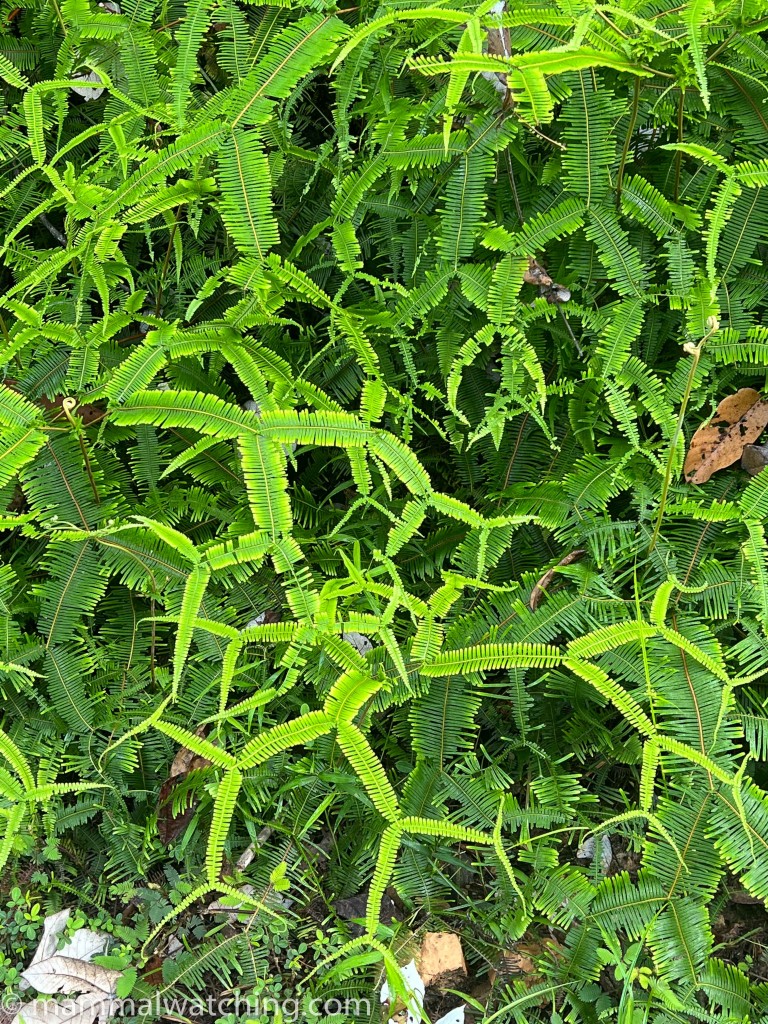
Food and Accommodation
The headquarters, in the middle of reserve, is a comfortable area to be based in. There are several guest bungalows each with two or three bedrooms that have ensuite bathrooms, hot water and good air conditioning. The dining room (below) churns out tasty food three times a day with several dishes to choose from. We could decide our own meal schedule and influence the menu (though if you expect to have your dinner at 11pm one night – as we did – the kitchen might politely push back). They usually have beer for sale. My cellphone worked there you can buy wifi through the office.
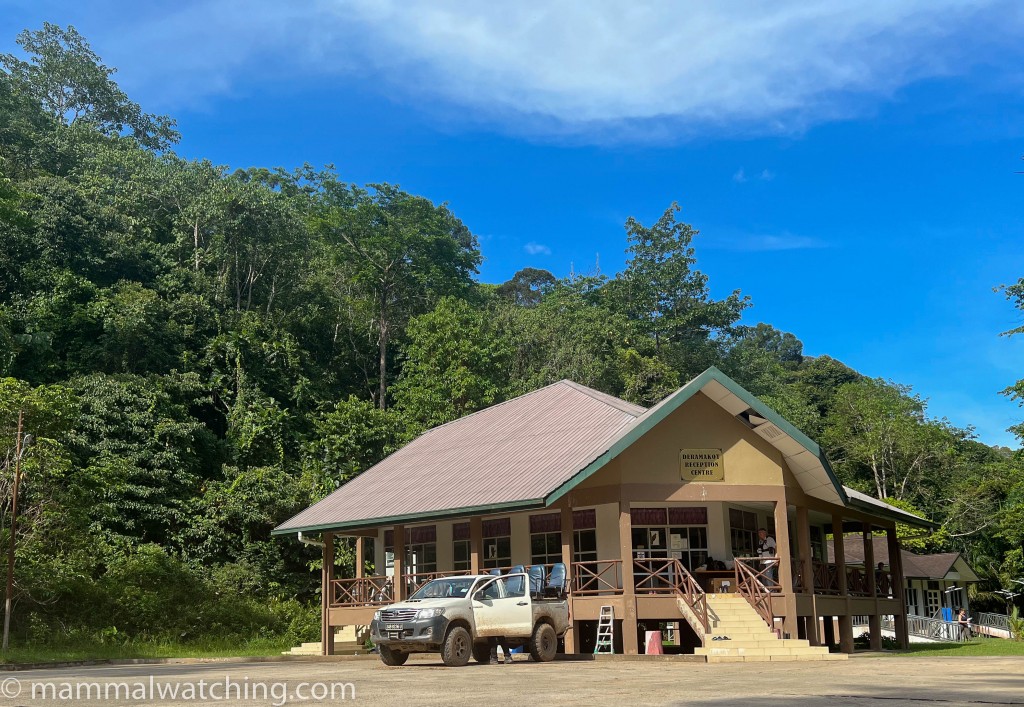
The Deramakot canteen
The Mammalwatching Set Up
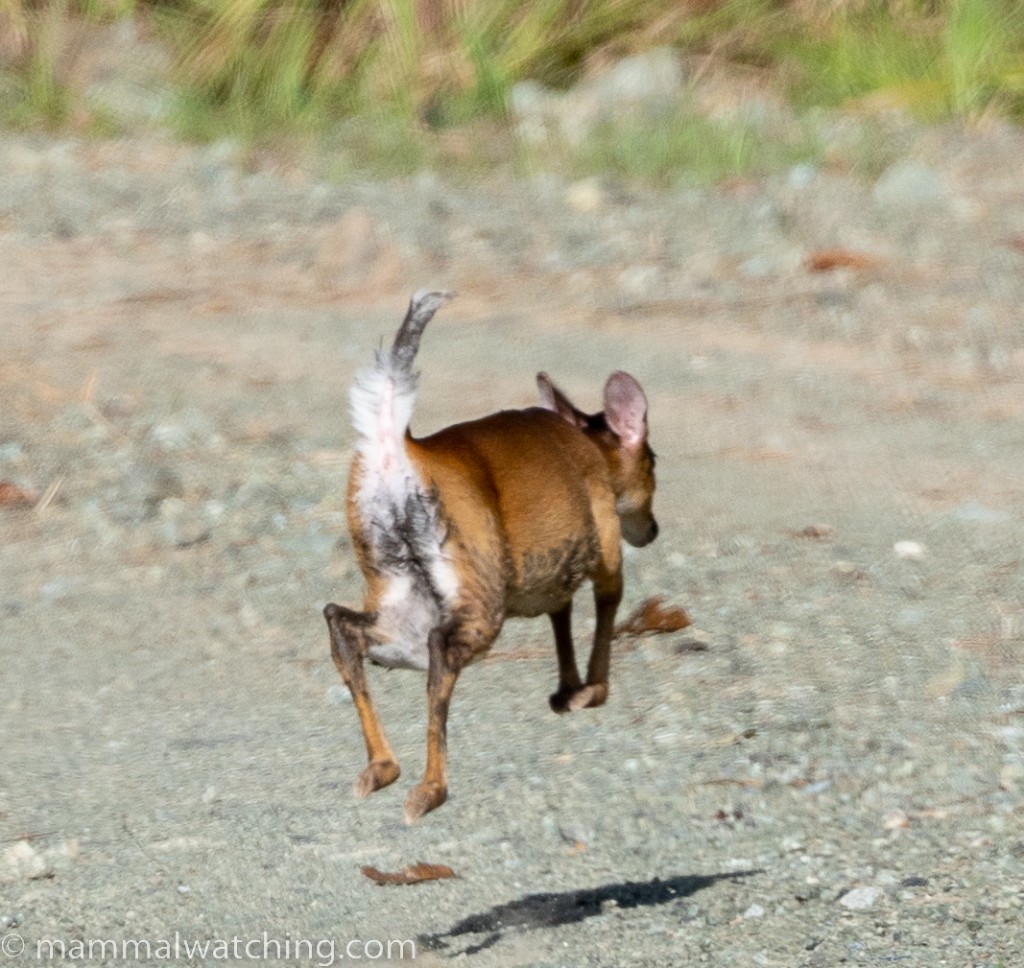
Bornean Yellow Muntjac (Muntiacus atherodes)
The only limitation on mammalwatching in Deramakot is your stamina. If you want to spend 24 hours every day in the forest it could be arranged (though not all with the same guide and driver). Adventure Alternative Borneo included 7 hours per day of vehicle use in our quote, but we could pay for extra in advance. We bought an additional 15 hours of car time which turned out to be exactly what we needed for our 8 days.
Nearly all of the mammalwatching is done from the back of a pick up and, given our target species, we quickly moved into full nocturnal mode only getting back into something closer to a diurnal routine for our last day or two in the park (by which I mean night drives ended at 1am rather than 5am). I don’t know if the 12 hour time difference from the USA made this easier or harder to adjust to. But its fair to say it wasn’t the most relaxing schedule though it was entirely self-inflicted. For the first week I did not sleep more than 4 hours straight until I realised I would likely survive if I skipped lunch some days and chose to sleep though it. I survived, though I missed pizza one day which was a blow.
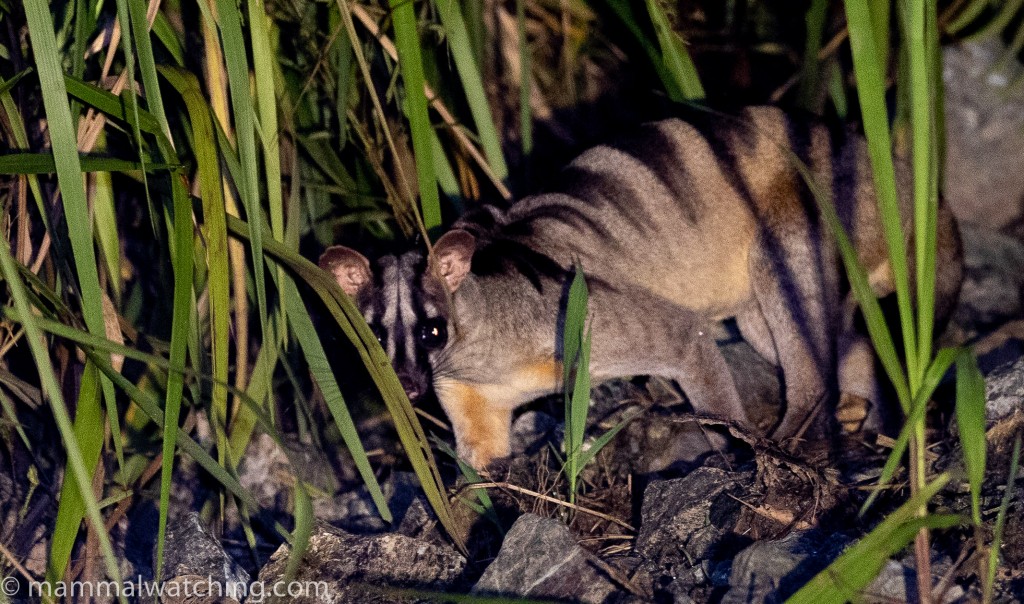
Banded Civet (Hemigalus derbyanus), Deramakot Forest.
We spent nearly all our time driving up and down the same 30km of the road that runs from the accommodation to the river. You start seeing animals very soon after leaving the headquarters area: we saw a Sun Bear just 3km along the road for instance. Once or twice we took the road out towards the entrance gate in the other direction. The forest looks just as good but for some reason isn’t always as productive, though it was 10km along this road that we saw our Bay Cat.
The only walking I did was along the short Ecology Trail that runs behind the accommodation. This used to be a reliable area for Tarsiers. I tried several nights at different times but saw only a few bats and a colugo. Charles, Mike and I walked the road once in the early morning for three kilometres. This walk can usually turn up Maroon Langurs and Gibbons. We ran into a pair of Yellow-throated Martens.
Mount Kinabalu National Park
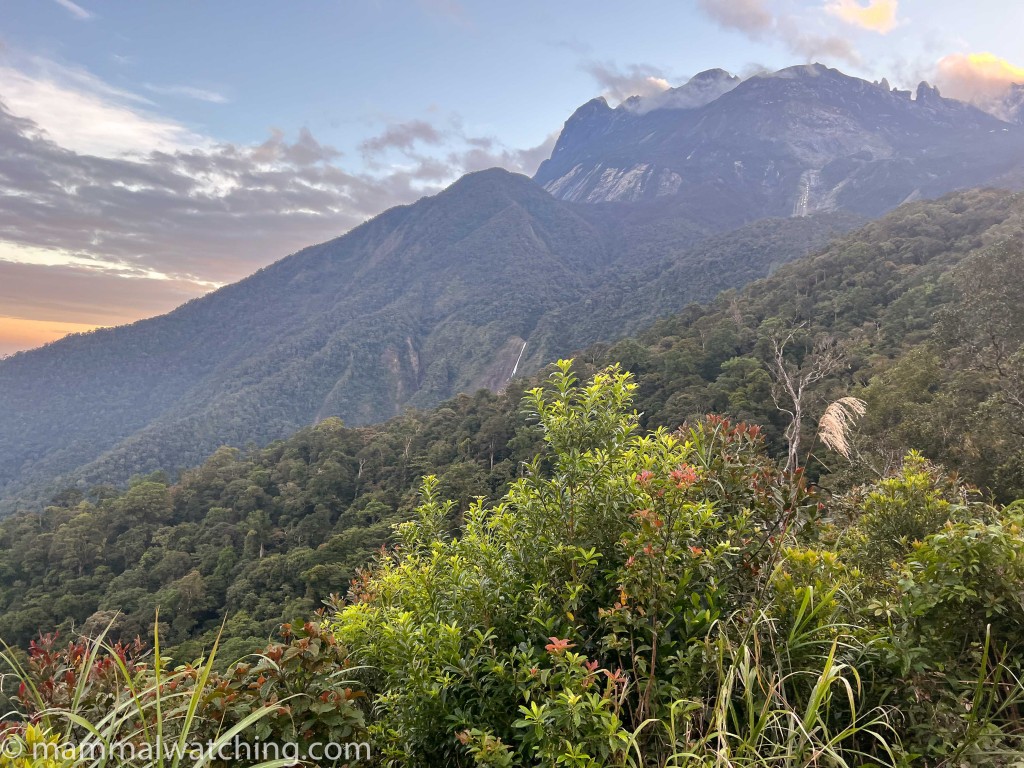
Mount Kinabalu’s summit
I visited Mount Kinabalu in 2004 and promised myself I would return. Based on recent reports the park may be one of the better places to see a Banded Linsang (both Fiona Reid’s 2017 trip and Tomer’s 2019 visit recorded them). It is also the squirrel capital of the world with several species we all wanted to see together with (seemingly remote) chances of a Marbled Cat and a Kinabalu Ferret Badger. We spent three nights here.
Accommodation and Food
There are a hotels just outside the park but we stayed in the park headquarters. The hotel here is popular and it took AA Borneo a while to find us all rooms. I gather it is also fairly expensive by Borneo standard. But the rooms are really lovely: this hotel could be a solid choice for a mammalwatching honeymoon. When we checked in there were various exclamations of “Oooh .. you have to come see my room”.
The food did not live up to the decor. Breakfast was good but our full board package came with the hotel’s set menu. And the hotel took the idea that set menu meant set in stone. After the fourth meal of rice, pepper beef and lemon chicken (all of which had had all the flavour surgically extracted) the a la carte menu became irresistible. A splinter group started paying extra for cheeseburgers (which the hotel eventually offered in lieu of the set menu). Consider going a la carte if you stay.
The Mammalwatching Set up
Mammalwatching at Kinabalu focussed on the 3.5km of road that leads from the accommodation to the Timpohon Gate. In 2004 the rangers let me walk past the gate and up the mountain for a few kms alone and without any fee. I just promised I wasn’t going to the top. Now it is much more regulated … we could not even set sit on the other side of the gate without paying for a guide to take us to the summit. Luckily there isn’t really much need, from a mammalwatching perspective, to go any beyond the gate.
More problematic is a recent change in the park’s road rules. A few month ago a road barrier was been set up at the bottom of the hill, next to the accommodation. The only way to drive up the road now is by taxi. The was the biggest frustration of the trip as it meant all our spotlighting – and Linsang searching – had to be done on foot. I suspect being on foot makes it harder to see a Linsang in any case, but it also cut down considerably on how many times we could go up and down the road looking for stuff.
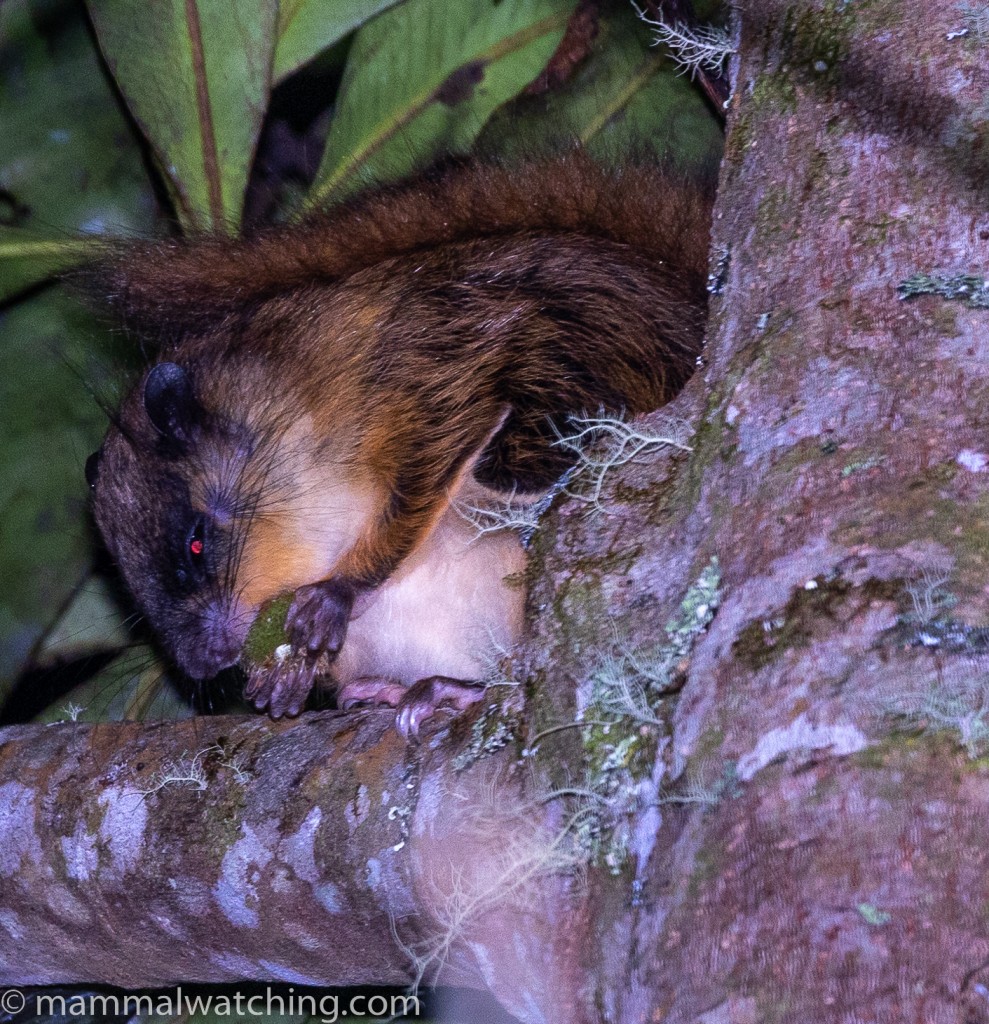
Whiskered Flying Squirrel (Petinomys genibarbis), Kinabalu National Park.
The hill is steep so we decided to take a taxi up and walk back down. At first we were told that we could only get a taxi up the hill before 3pm. This got later each day and by the last day our taxi driver was ready to drive us up to the top at 7pm, which meant we had time to eat dinner and walk down slowly, rather than rush down to eat at 9pm before the kitchen shut.
During daylight the road itself was not all that productive. The area immediately in front of our rooms was one centre of squirrel activity, as was the area around the Timpohon Gate at the top of the road (and after dark the rats took over from the squirrels). A dumpster at the end of the road was one hot spot, as was the area around the pedestrian gate too. Spotlighting on foot down the road produced Spotted Giant Flying Squirrels and Striped Palm Civets all three nights plus a Whiskered Flying Squirrel. But no Banded Linsang.
Sayap Substation
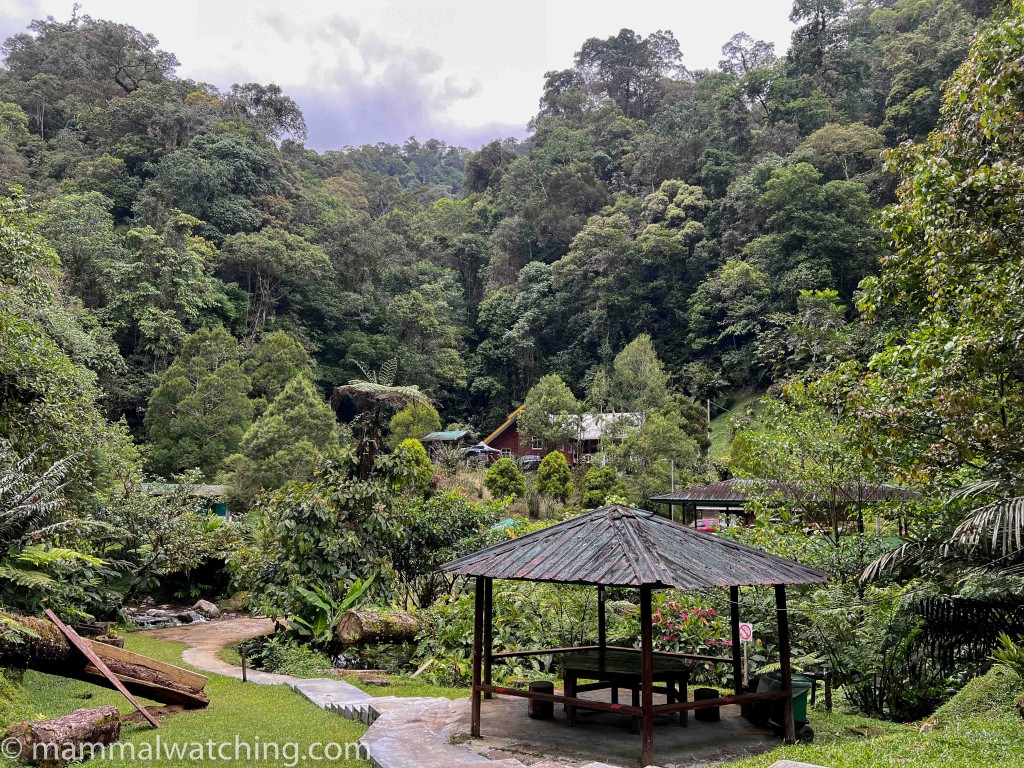
Sayap Substation HQ
Sayap Substation is also on Mount Kinabalu but on the north side. Probably only 40km or so as the hornbill flies from the park headquarters it is a 2.5 hour circuitous drive. The forest altitude here is up at around 1000 metres. It is seldom visited by mammalwatchers but Sophie and Manuel Baumgartner saw everyone’s favourite squirrel – the Tufted Ground Squirrel – here in 2019. Mike Gordon reckoned there was as much chance of us seeing one here as anywhere else as easily accessible so we thought we would give it a shot for a couple of nights.
Food and Accommodation
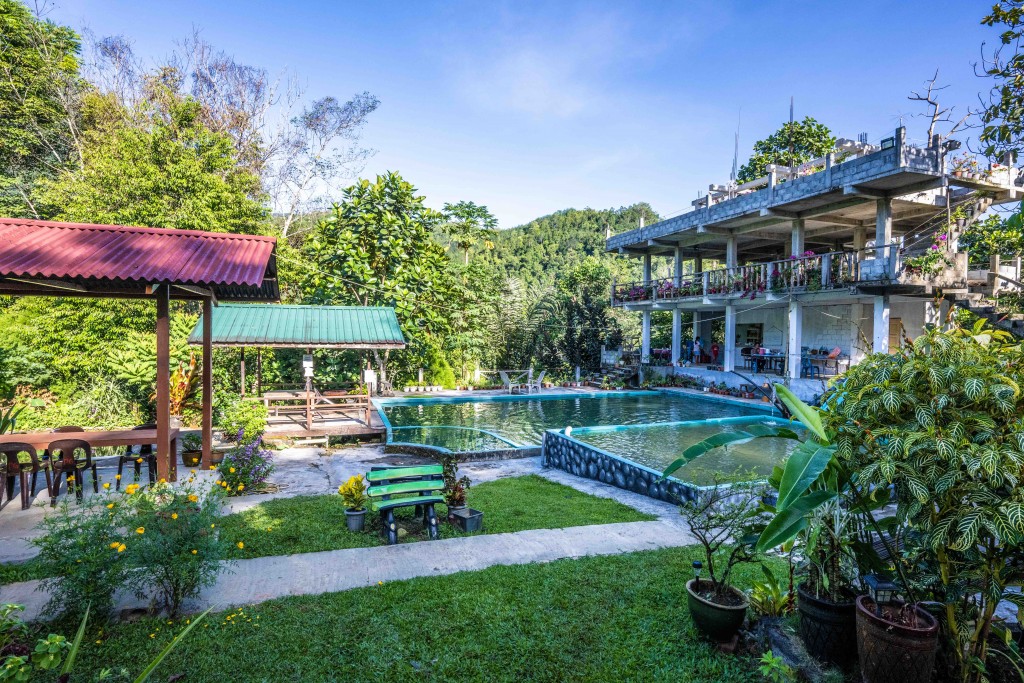
Porohon Garden Homestay. Photo Charles Hood.
We stayed at the simple Porohon Garden Lodge homestay, about 40 minutes drive from the park. It is clean and comfortable and the food tasty. It comes with its own swimming pool, fed by a hosepipe from the river running through the gardens.
The Mammalwatching Set Up
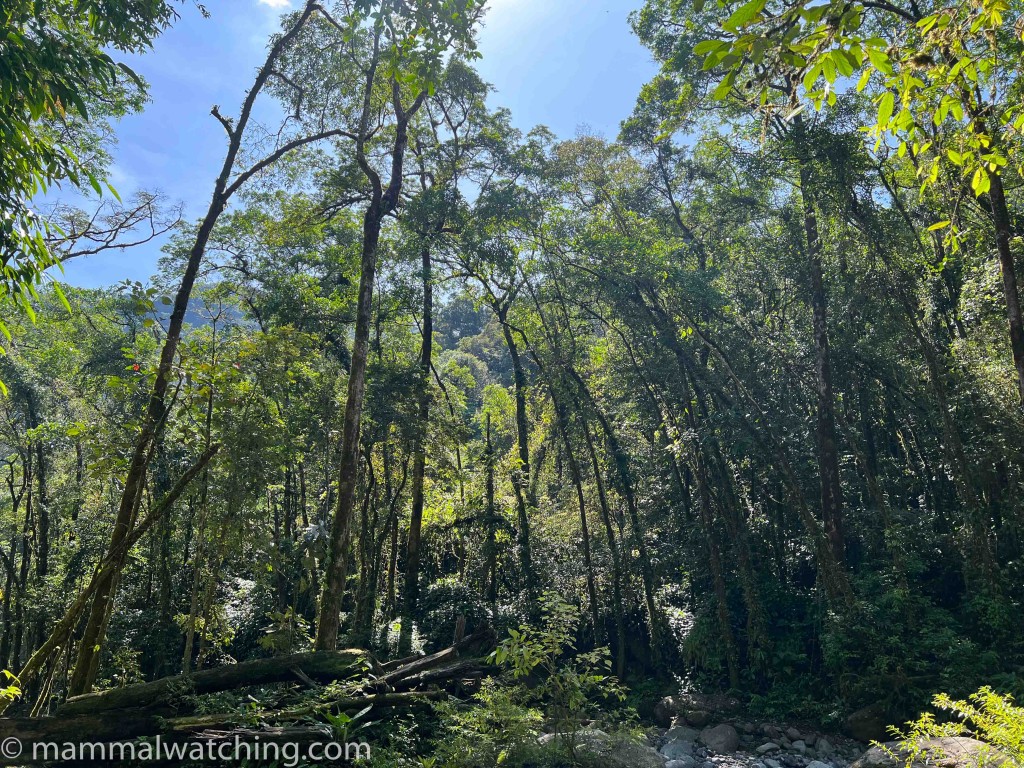
Sayap forest
The Sayap Substation has a network of trails. Most of them are steep, narrow and slippery so not ideal for mammalwatching as you had to spend your time looking at your feet rather than around you.
A disused road leads up the hill for a kilometre or so from the office and we spent all our time on that. The first 300 metres were very steep but it was at least wide enough to allow us to walk next to each other. An enormous tree, two hundred metres up the road, was alive with squirrels of multiple species on our first morning and we spent time here, taking plastic chairs up on the second morning so we could squirrel-spot in something approaching comfort. The ranger told us, as we were leaving, that he had seen Tufted Ground Squirrels “many times” crossing the trail near to this tree. So we were in the right area even though we didn’t see a Tufted Ground Squirrel.
Mammal list
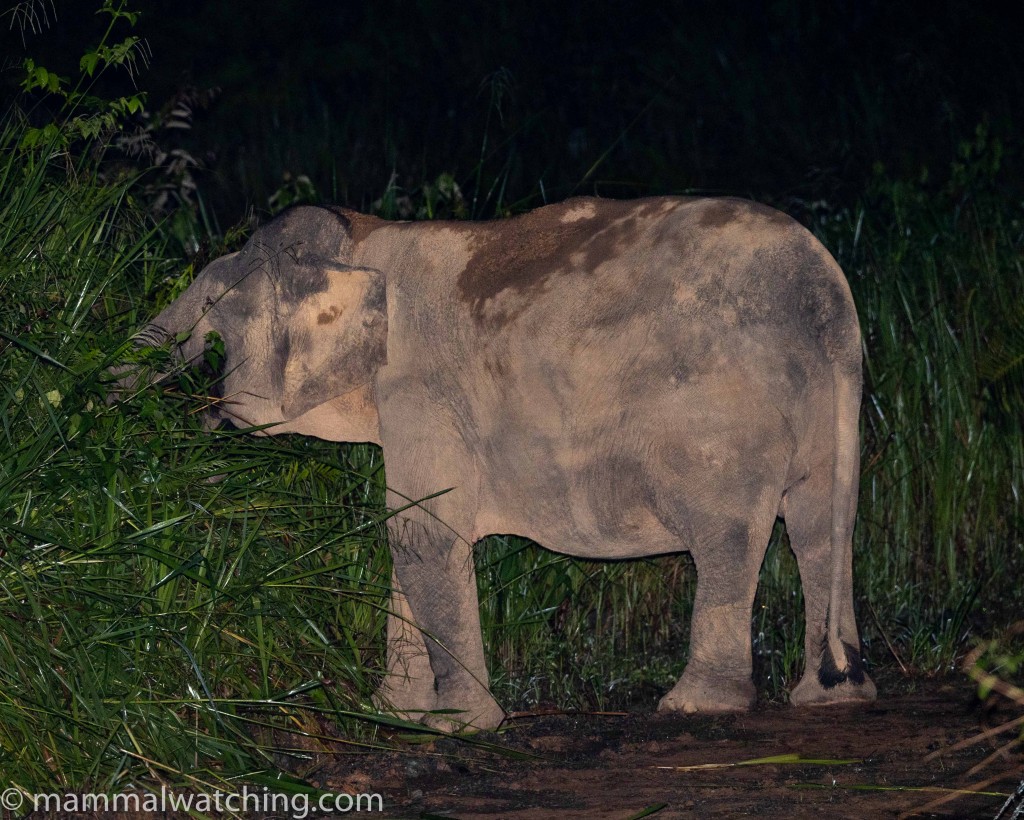
Bornean Pygmy Elephant (Elephas maximus)
Asian Elephant (Elephas maximus): there was a group every night moving along the main Deramakot road.
Pale Giant Squirrel (Ratufa affinis): one or two on Mount Kinabalu near the Park HQ and another at Sayap.
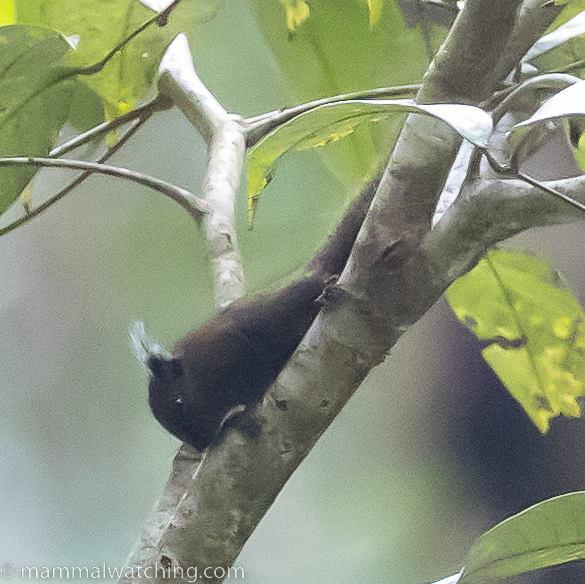
Tufted Pygmy Squirrel (Exilisciurus whiteheadi)
Tufted Pygmy Squirrel (Exilisciurus whiteheadi): we did not make any particular effort to find these beautiful little squirrels in Kinabalu NP after Mike said they were abundant at Sayap. They were and we many in the forest there. Lifer.
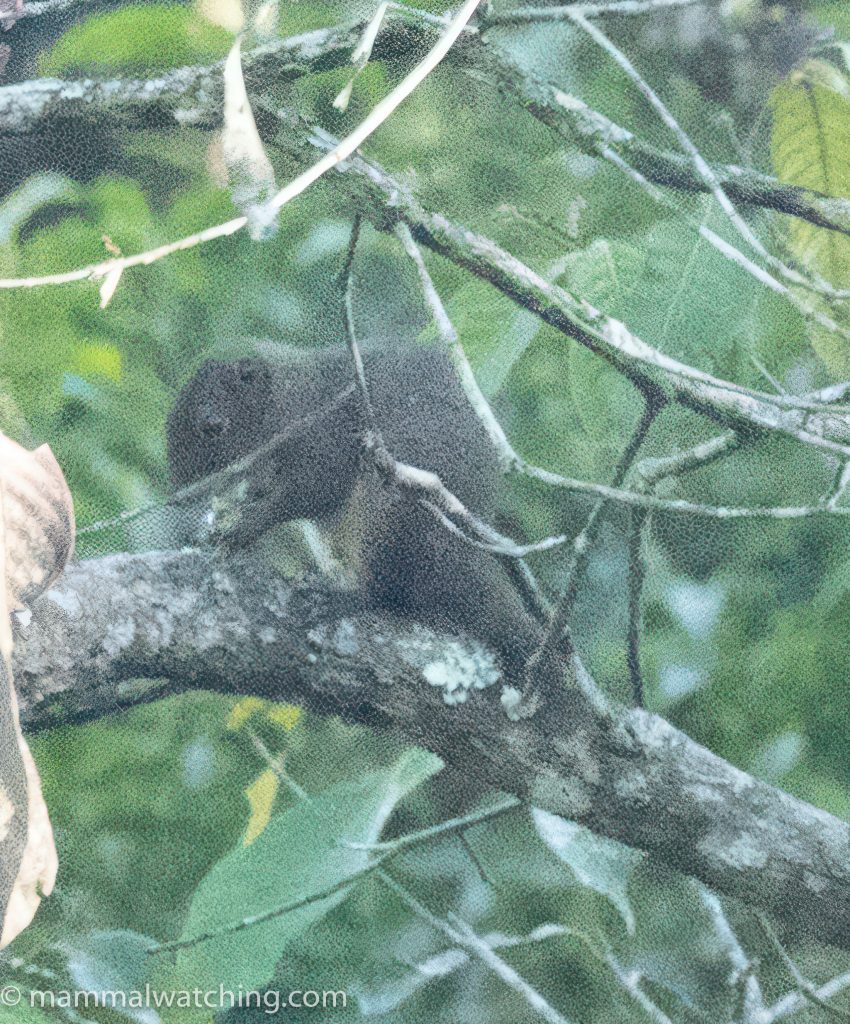
Brooke’s Squirrel (Sundasciurus brookei), Kinabalu NP
Brooke’s Squirrel (Sundasciurus brookei): these rather drab squirrels are in Kinabalu NP but quite easy to confuse with Mountain Ground Squirrels (as I discovered- thanks Daan Drukker!). I saw one quite close to the staff accommodation (just below the main park hotel). From this very distant picture it is difficult to rule out a Mountain Ground Sqiurrel but this animal was high in a a big tree so ought to be Brooke’s. Lifer.
Bornean Mountain Ground Squirrel (Sundasciurus everetti): easy to see in Kinabalu NP around the Timpohon Gate and the trash.
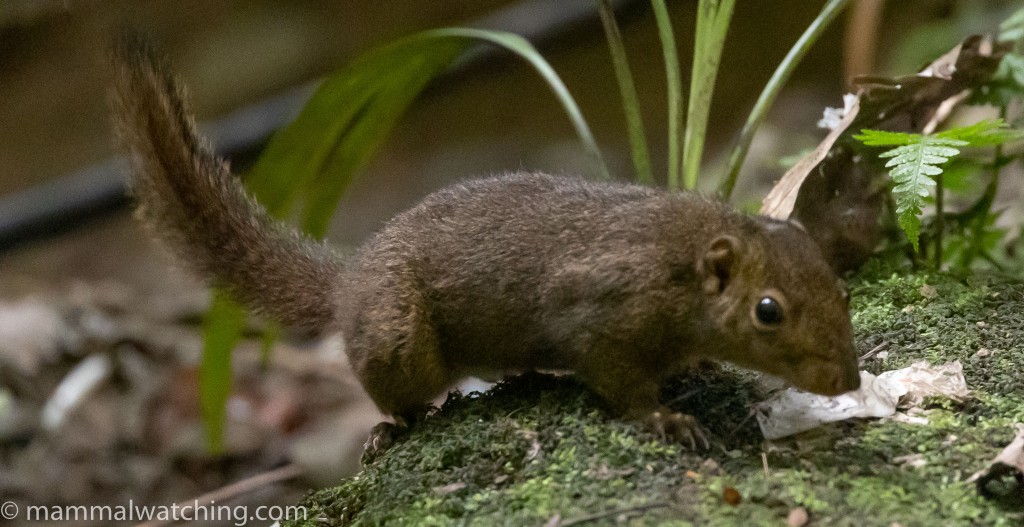
Bornean Mountain Ground Squirrel (Sundasciurus everetti)
Jentink’s Squirrel (Sundasciurus jentinki): two or three on Kinabalu, including one at the visitor centre when we arrived to pay the park fees. One or two more at Sayap. They were flighty and hard to photograph. They were more confiding and easy to see in 2004 along the trail up the mountain.
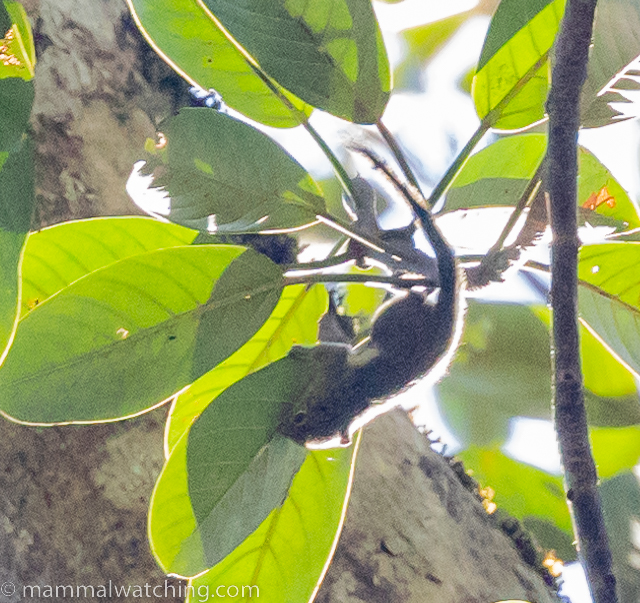
Sculptor Squirrel (Glyphotes simus), Sayap Substation.
Sculptor Squirrel (Glyphotes simus): We saw several in Sayap high up in the big “squirrel” tree described above, often seeming to feed on the underside of leaves exactly as Quentin Phillips describes in his field guide.
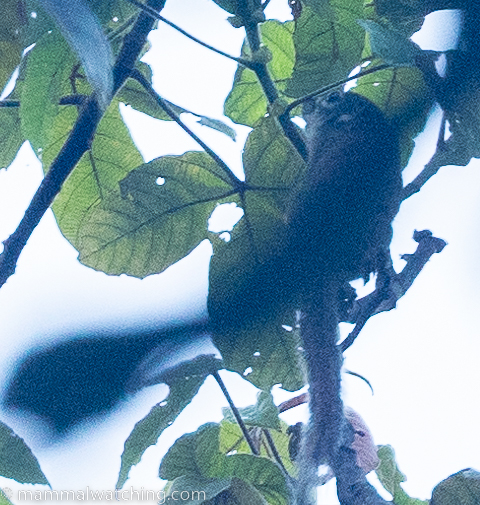
Sculptor Squirrel (Glyphotes simus), Sayap Substation.
They are reported to be one of the more difficult squirrel squirrels to find on Kinabalu so Daan Drukker got quite excited by the animal in the photo below which might be a Sculptor Squirrel. It was in a small tree right next to the Kinabalu park staff accommodation. If anyone knows for sure please let me know.Lifer.
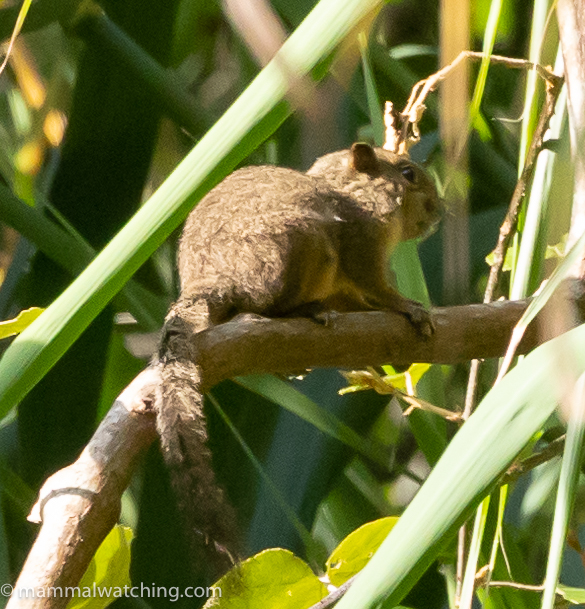
Possible Sculptor Squirrel (Glyphotes simus), Kinabalu NP.
Plantain Squirrel (Callosciurus notatus): we saw only one in Deramakot, though as we spent very little time awake in the day that is not so suprising. Another was seen close to a restaurant on the way up to Kinabalu. A very common species.
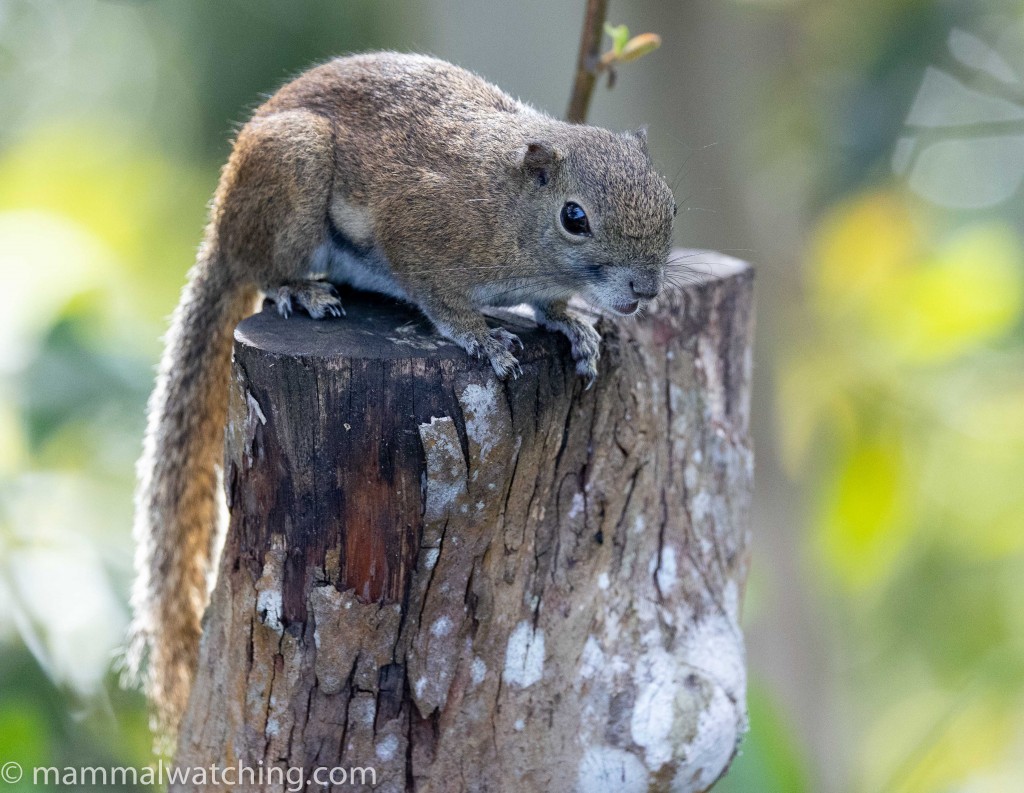
Borneo Black-banded Squirrel (Callosciurus orestes)
Borneo Black-banded Squirrel (Callosciurus orestes): very common and confiding on Kinabalu and at Sayap.
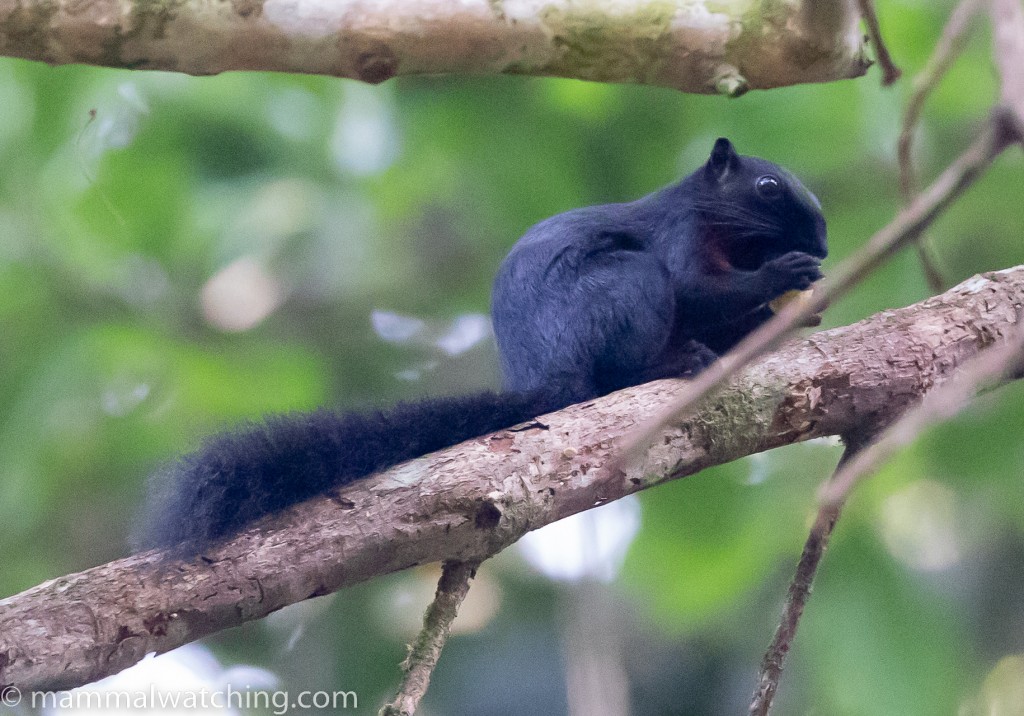
Prevost’s Squirrel (Callosciurus prevostii)
Prevost’s Squirrel (Callosciurus prevostii): several seen in Deramakot and another at Sayap.
Javanese Flying Squirrel (Iomys horsfieldii) (?): we had a brief look at a smallish (but not tiny) flying squirrel on Kinabalu with an orange tinge. Probably this species.
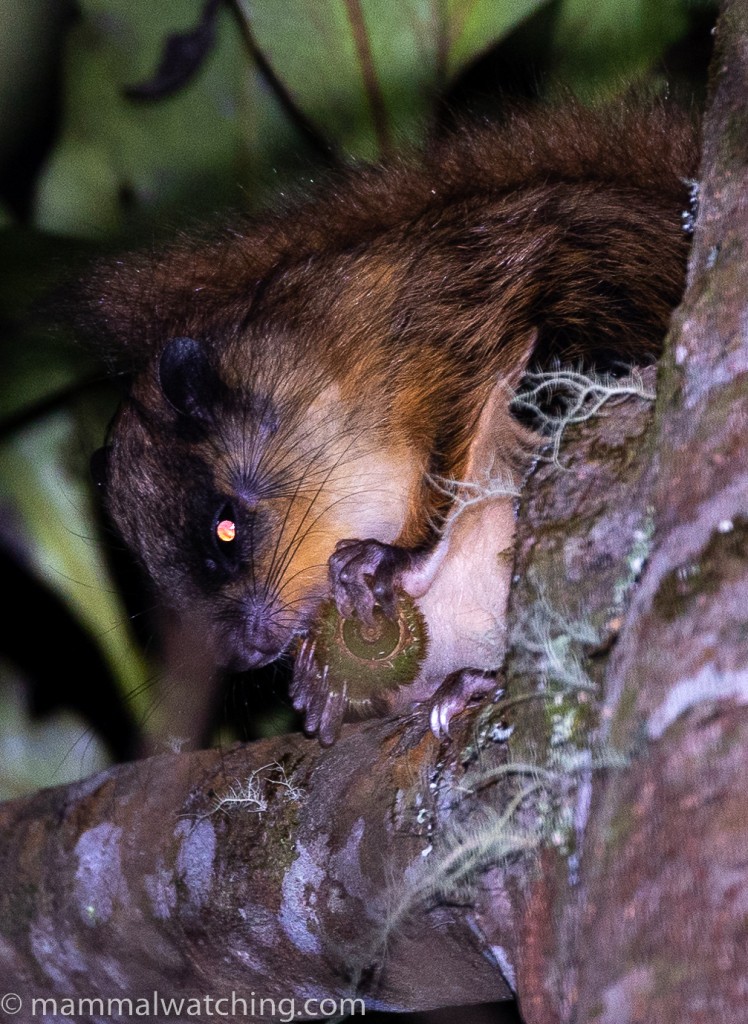
Whiskered Flying Squirrel (Petinomys genibarbis)
Whiskered Flying Squirrel (Petinomys genibarbis): fifteen minutes or more with a very relaxed individual at the side of the road on Kinabalu, about half way between the accomodation and the Timpohon Gate. Easy to identify from the “wart” sprouting whiskers just above the eye. Lifer.
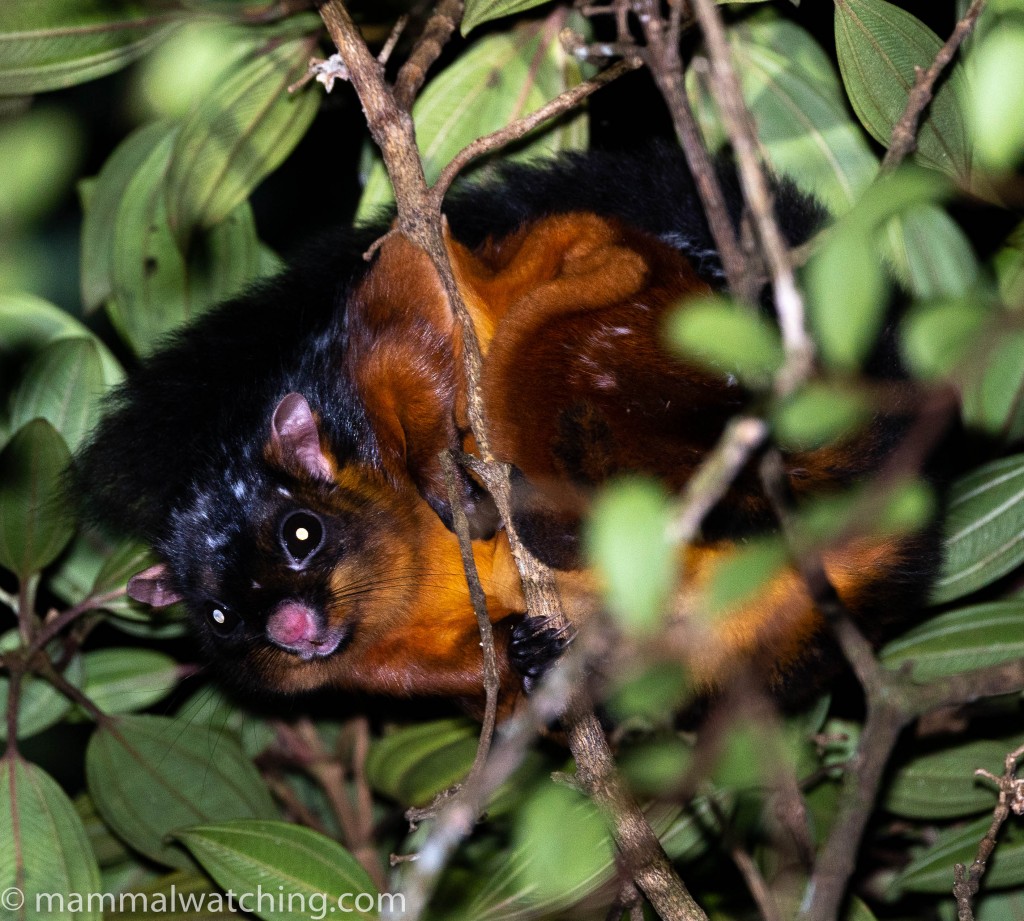
Spotted Giant Flying Squirrel (Petaurista elegans)
Spotted Giant Flying Squirrel (Petaurista elegans): one or two every night on Kinabalu while spotlighting on foot down the road from the Timpohon Gate to the hotel. Lifer.
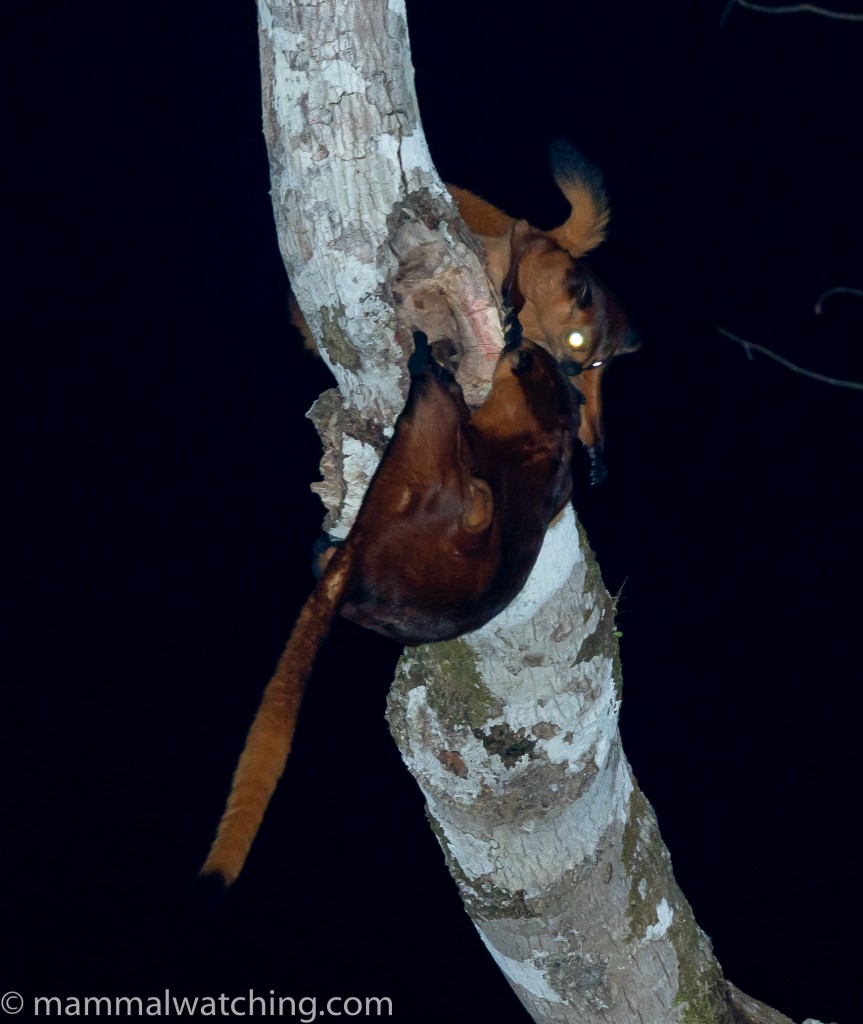
Common Giant Flying Squirrel (Petaurista petaurista)
Common Giant Flying Squirrel (Petaurista petaurista): very common in Deramakot.
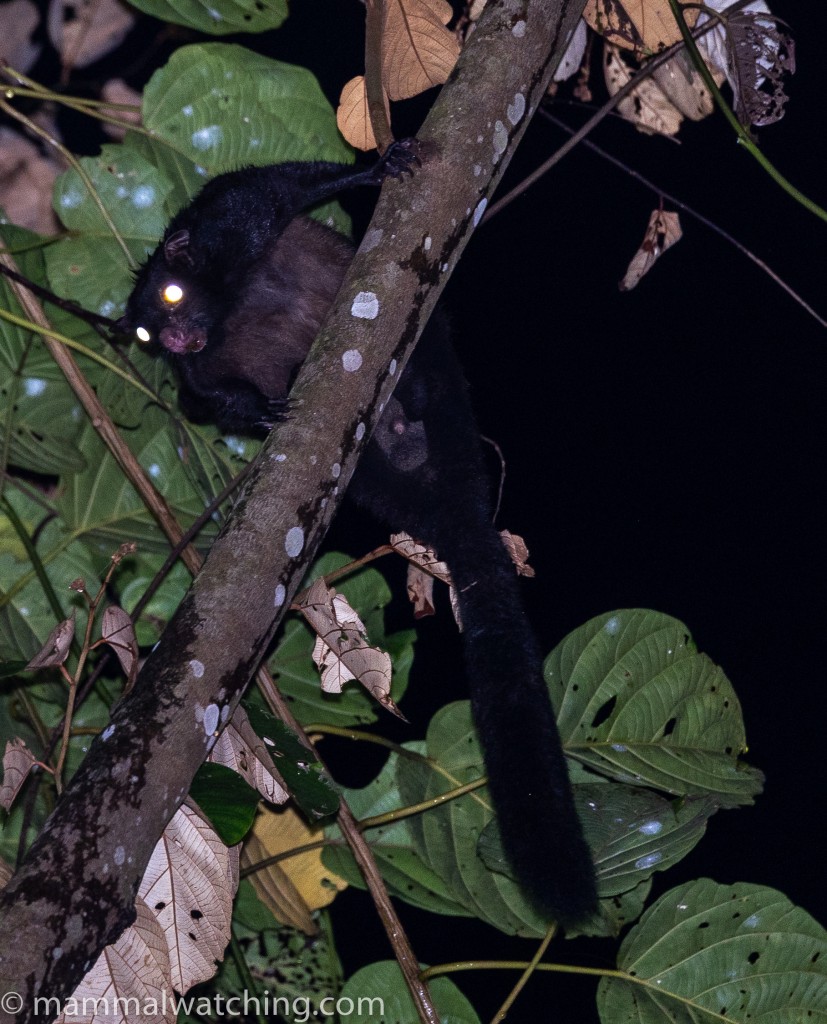
Black Flying Squirrel (Aeromys tephromelas)
Black Flying Squirrel (Aeromys tephromelas): several in Deramakot (perhaps 1 in 20 flying squirrels there were black) and another in Sayap.
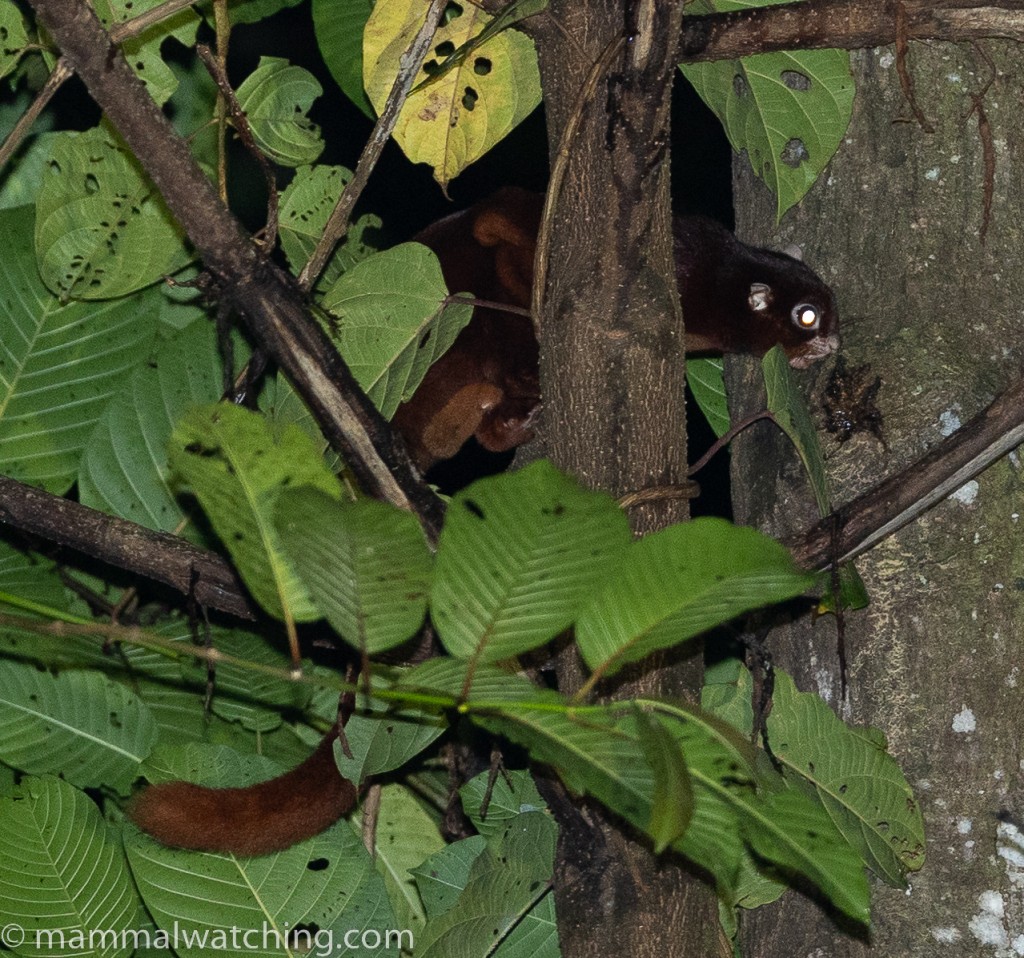
Thomas’s Flying Squirrel (Aeromys thomasi)
Thomas’s Flying Squirrel (Aeromys thomasi): the most commonly seen mammal in Deramakot. Dozens on every night drive.
Greater Pencil-tailed Tree Mouse (Chiropodomys major): there are few mouse-sized rodents in Deramakot and though our views were fleeting these were easy to identify on the basis of size and tail length.
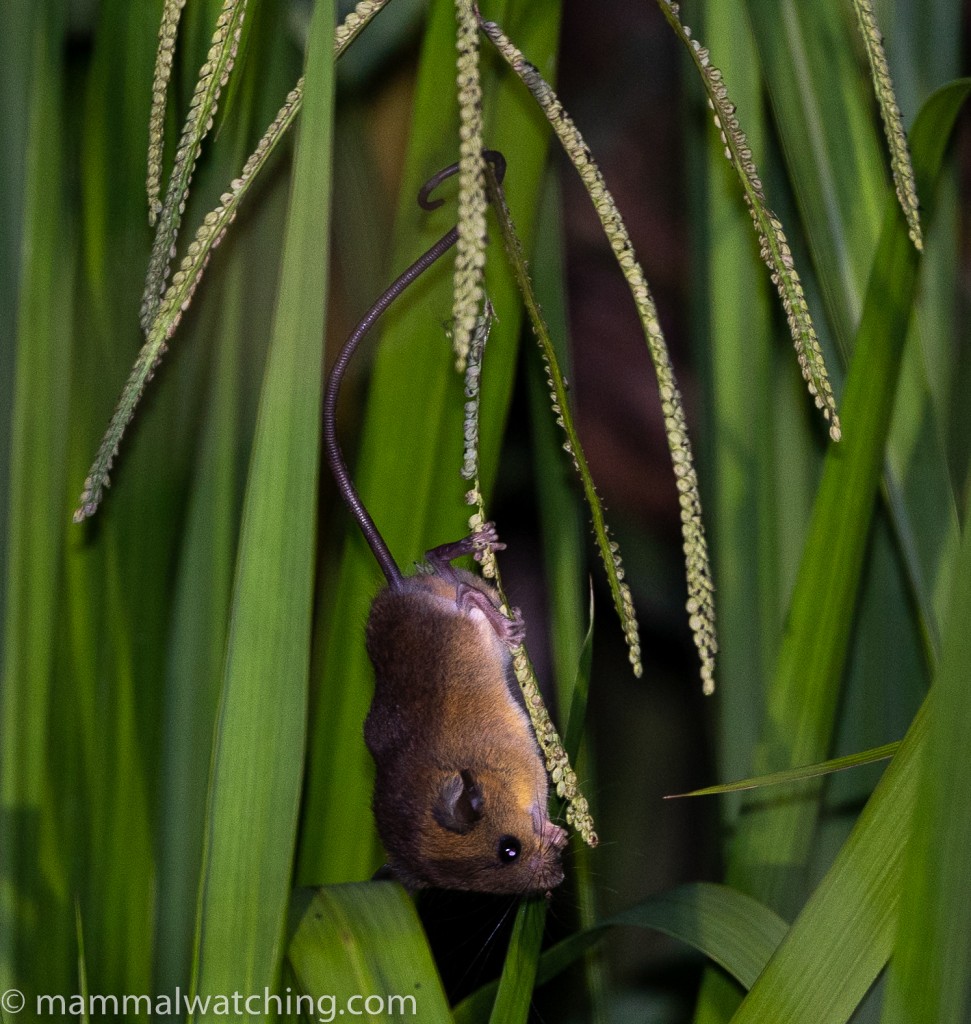
Lesser Ranee Mouse (Haeromys pusillus), probably.
Sundaic Haeromys or Lesser Ranee Mouse (Haeromys pusillus): Mike Gordon spotted a few of these beautiful mice feeding in long grass on the road side after rain in Deramakot. Borneo has two almost identical species that differ slightly in size.
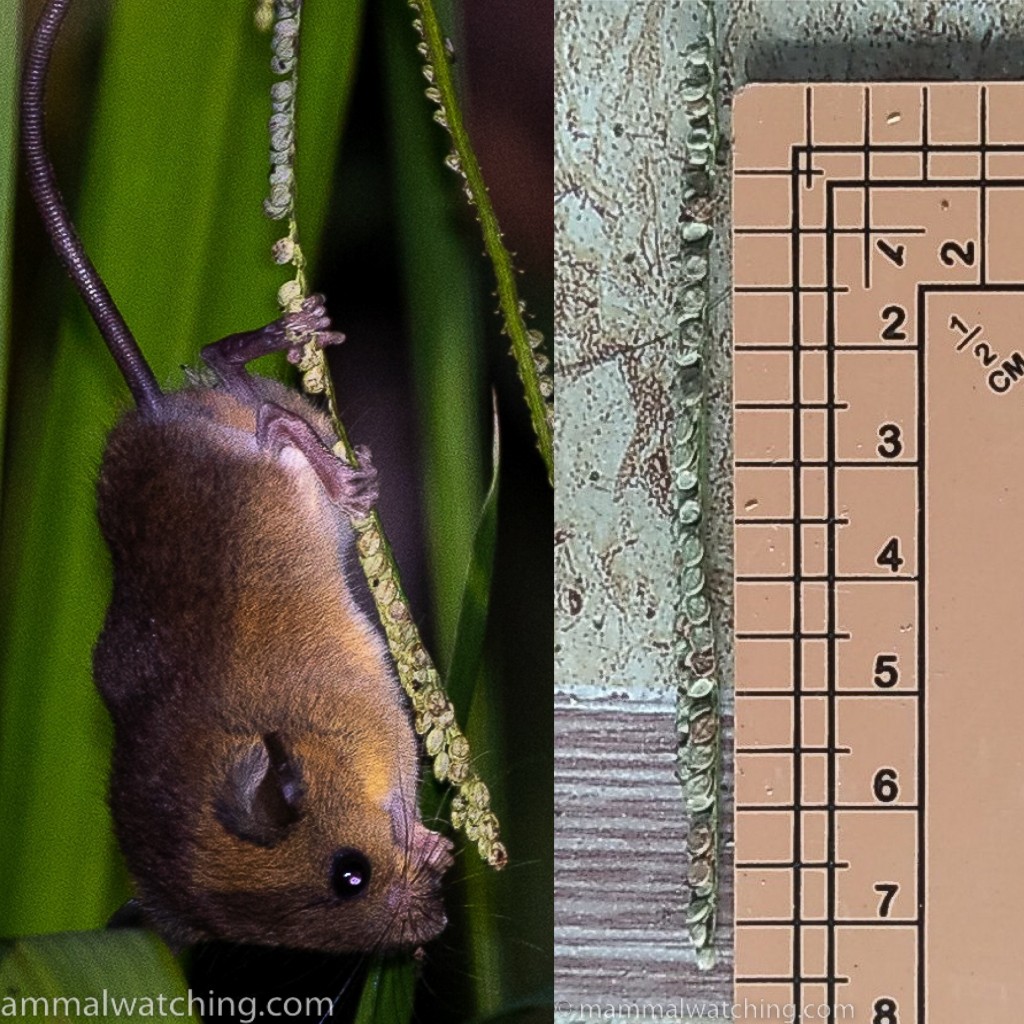
Regular or Lesser Ranee Mouse? We say “Lesser” if the seeds are to scale …
We estimated this animal – which we saw very well – as having a head body length of about 5 cm which we double checked against this image of grass next to a ruler (taken by Mike). So to me it looks like it should be the smaller (5cm body) species. But would love to hear what others think. Lifer.
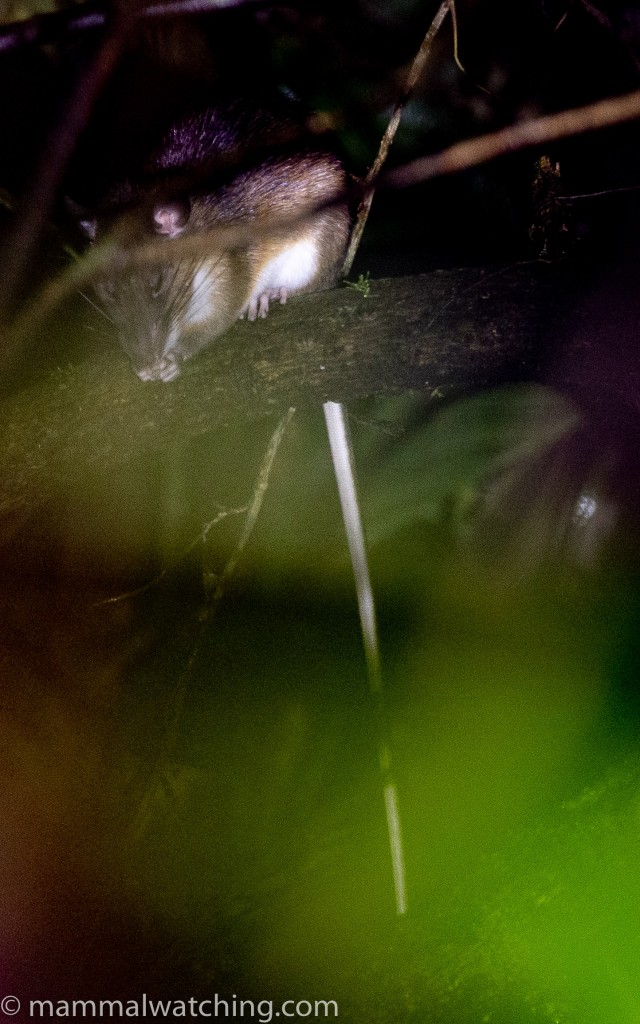
Montane Bornean Niviventer (Niviventer rapit)
Montane Bornean Niviventer (Niviventer rapit): we saw one of these large rats, with a very very long tail, at Sayap Substation. The illustrations don’t do the tail justice: it was at least twice as long as the head body, bright white underneath and dark above. It looked like a length of electric flex hanging under the animal. Half rat, half table lamp. Lifer.
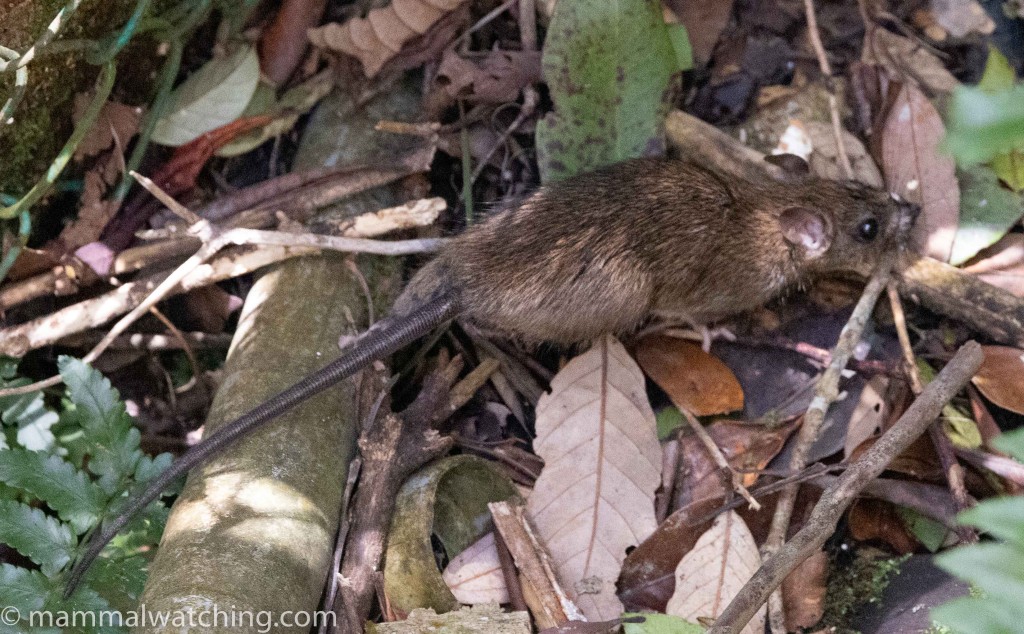
Kinabalu Rat (Rattus baluensis)
Kinabalu Rat (Rattus baluensis): we saw what appeared to be two Kinabalu Rats living right under the Timpohon Gate on Kinabalu and active in the mid morning. One was much larger than the other, but they were otherwise very similar with tails longer than the length of their head and body and dark feet. The only Rattus on Kinabalu are Tioman Rat (which have white feet), Polynesian Rats (too small) or Asian House Rats (which have paler flanks and larger ears, though this is hard to judge). Lifer.
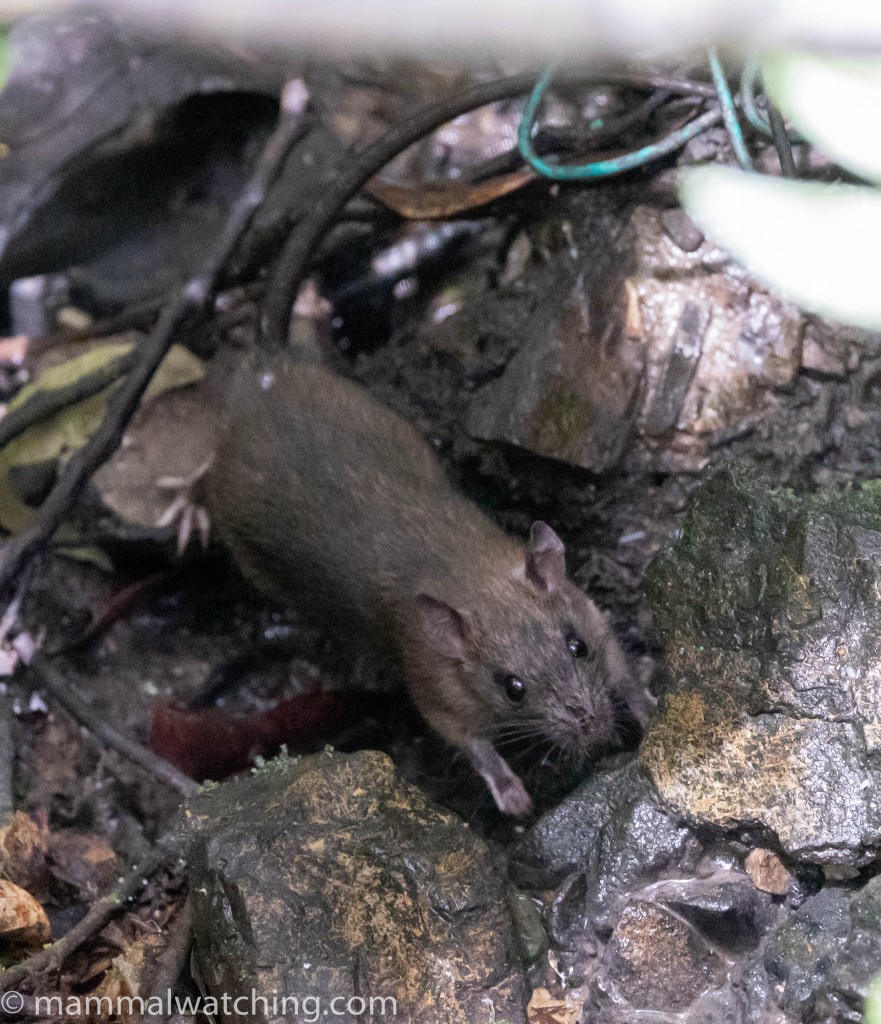
Kinabalu Rat (Rattus baluensis)
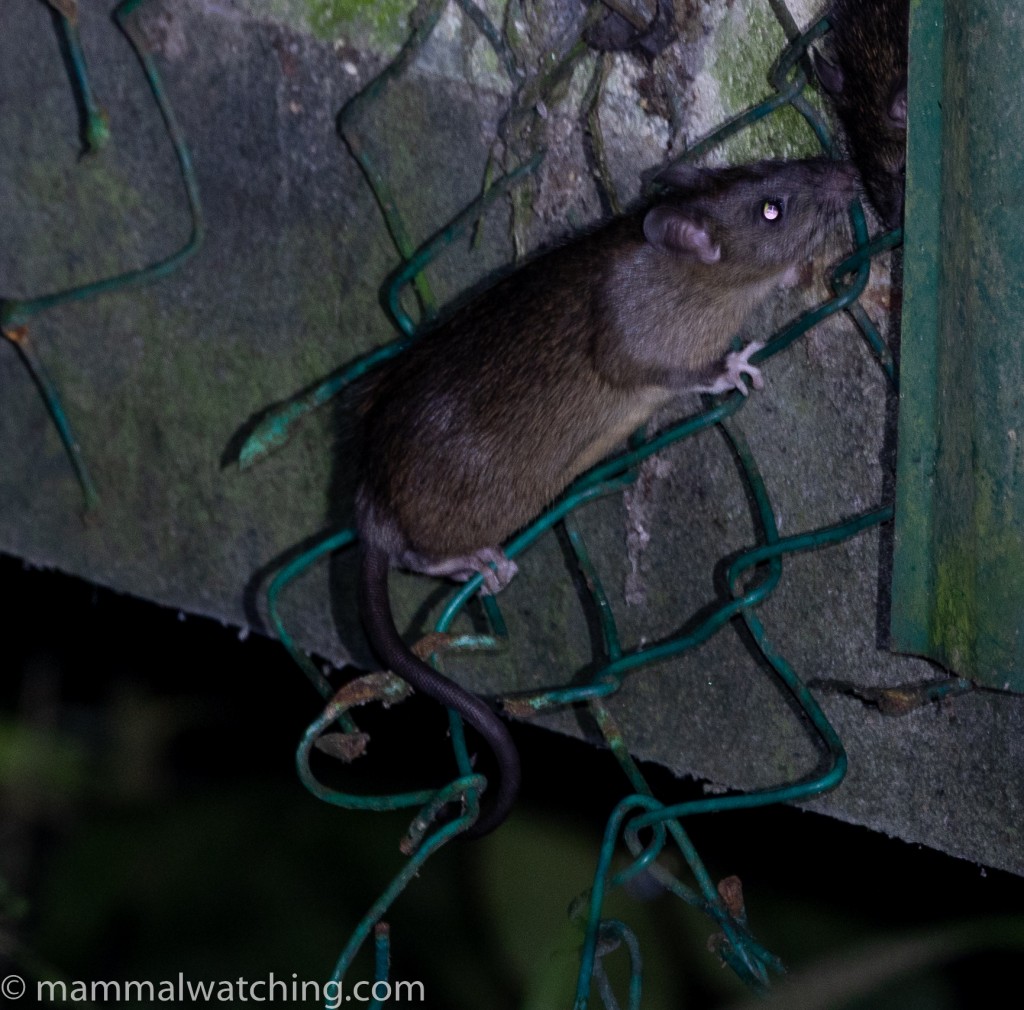
Asian House Rat (Rattus tanezumi)
Asian House Rat (Rattus tanezumi): one or more rats medium-sized raiding the garbage in the dumpster at the Timpohon Gate on Kinabalu appeared to be this species. Their size and colouration plus uncolored tail seems to rule out most the species that have been recorded from the area (between 1500- 2400 meters up Kinabalu) in recent trapping work, so this species seems most likely. Lifer.
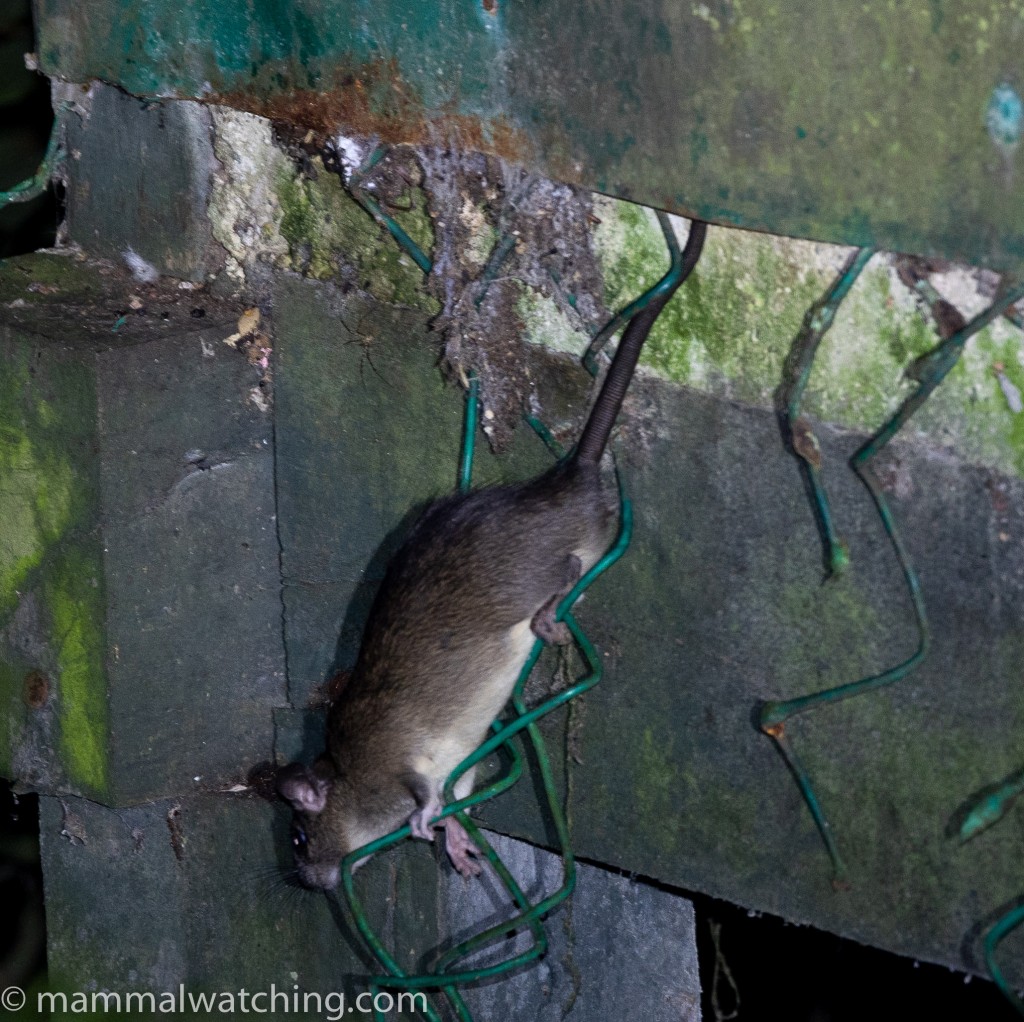
Asian House Rat (Rattus tanezumi)
Long-tailed Giant Rat (Leopoldamys sabanus): one of these whopping great rats was raiding the dumpster at night at the Timpohon Gate on Kinabalu.
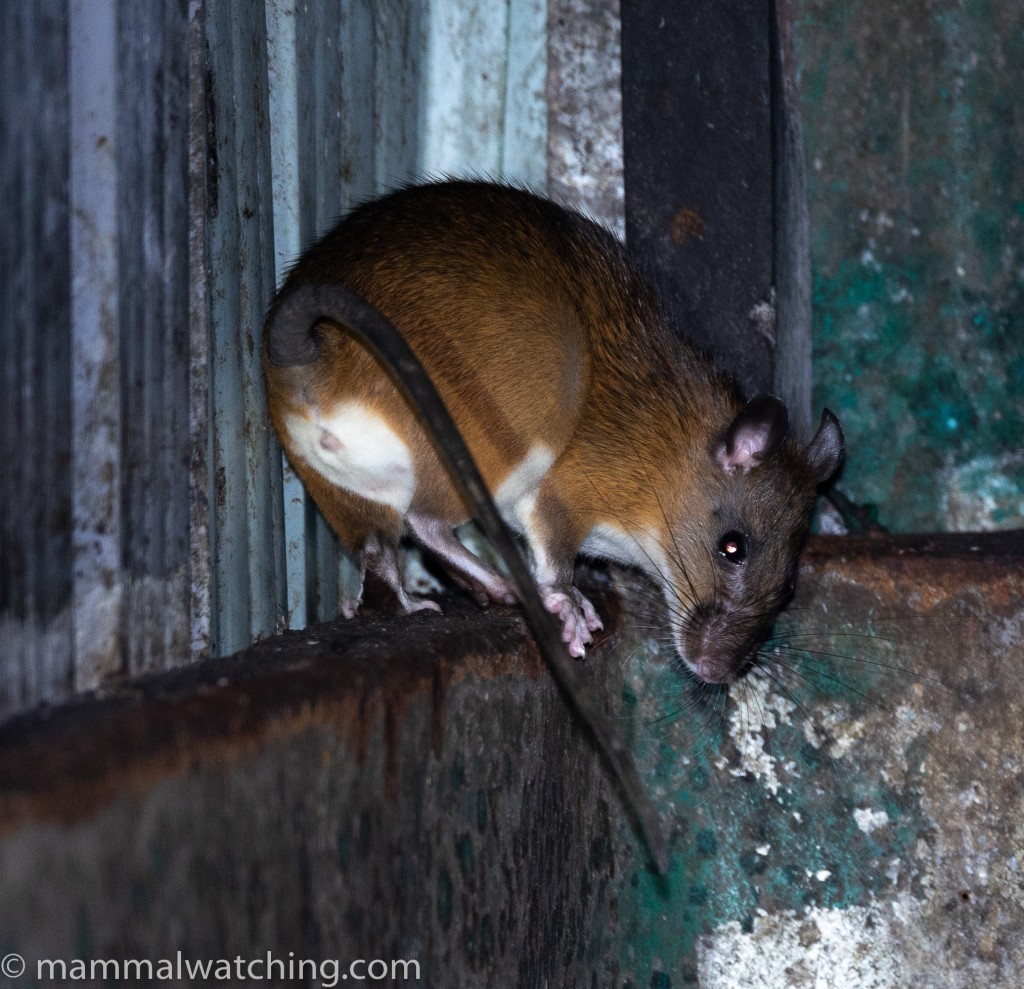
Long-tailed Giant Rat (Leopoldamys sabanus)
Grey Tree Rat (Sundaic Lenothrix) (Lenothrix cana): we saw two at night in Deramakot. Their large size , grey colour and lengthy white terminal portions of their tails make them easy to identify.
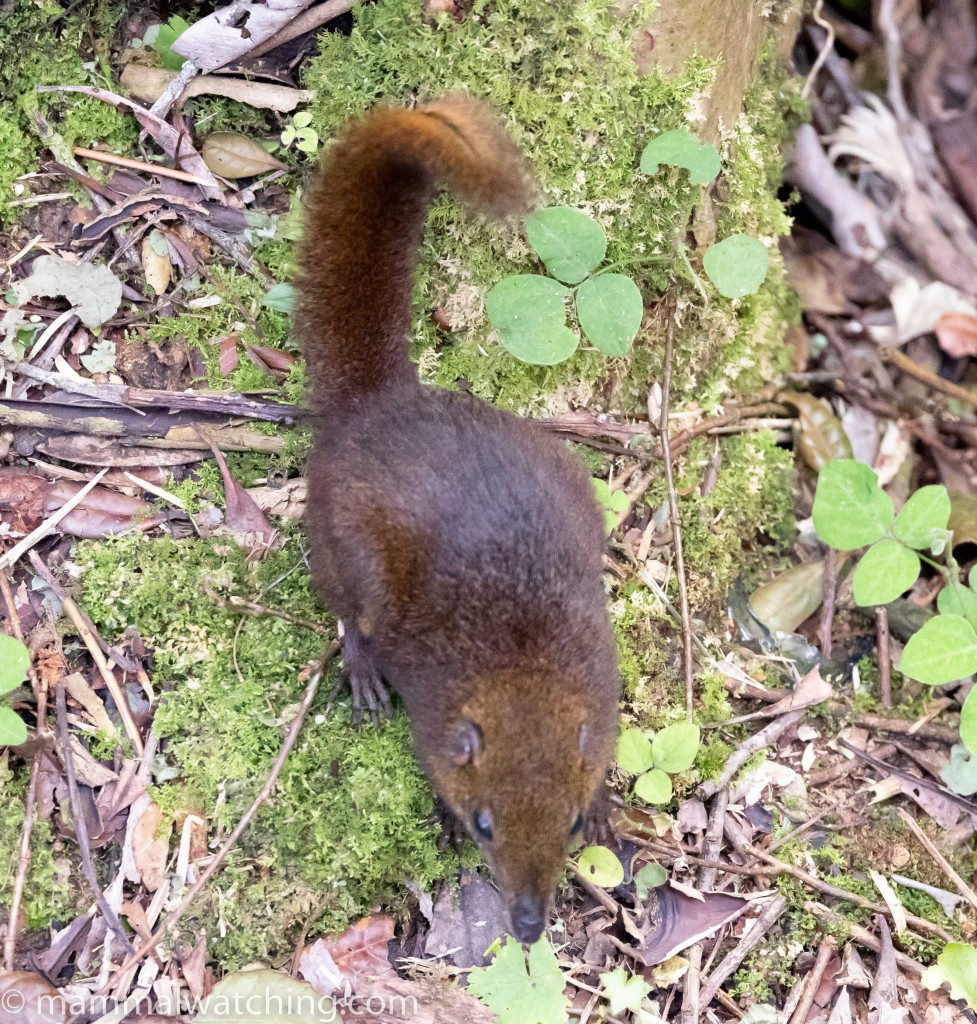
Mountain Treeshrew (Tupaia montana)
Mountain Treeshrew (Tupaia montana): several at Timpohon Gate in Kinabalu NP around the gate itself and the rubbish. A few others seen along the road.
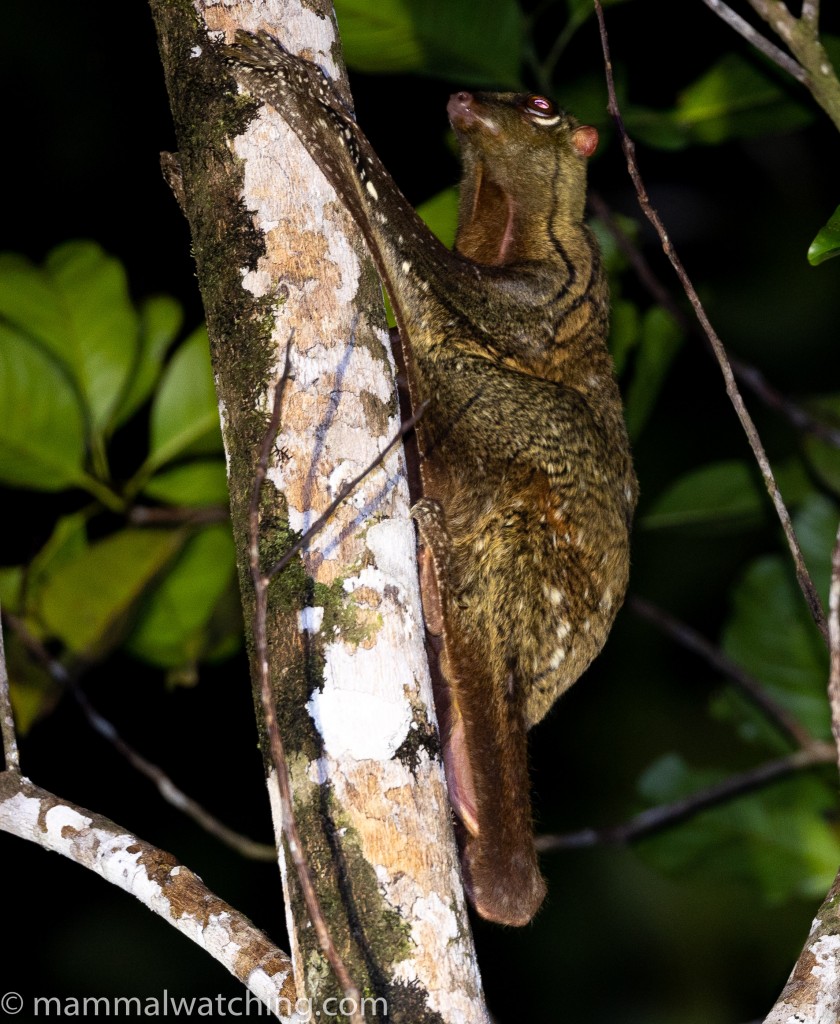
Sunda Flying Lemur (Galeopterus variegatus)
Sunda Flying Lemur (Galeopterus variegatus): seen most nights in Deramakot.
Philipine Slow Loris (Nycticebus menagensis): seen most nights in Deramakot though always at a distance.
Crab-eating Macaque (Macaca fascicularis): one sleeping at night in Deramakot.
Southern Pig-tailed Macaque (M.nemestrina): several in Deramakot along the road and some sleeping in trees by the river.
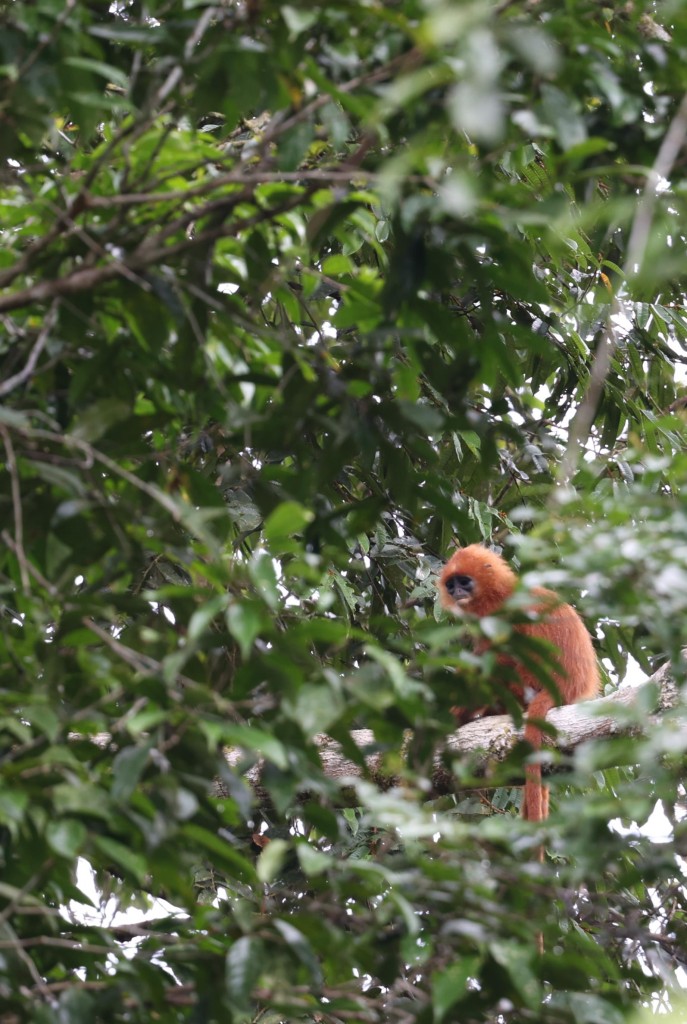
Maroon Leaf Monkey (Presbytis rubicunda). Photo Ian Thompson.
Maroon Leaf Monkey (Presbytis rubicunda): we heard them calling several times in Deramakot but only Ian made the effort to go and track one down early in the morning close to the accommodation.
Northern Gray Gibbon (Hylobates funereus): we heard them in Deramakot at dusk and also at 3 and 4am. Charles got a glimpse of one early in the morning near to our accommodation.
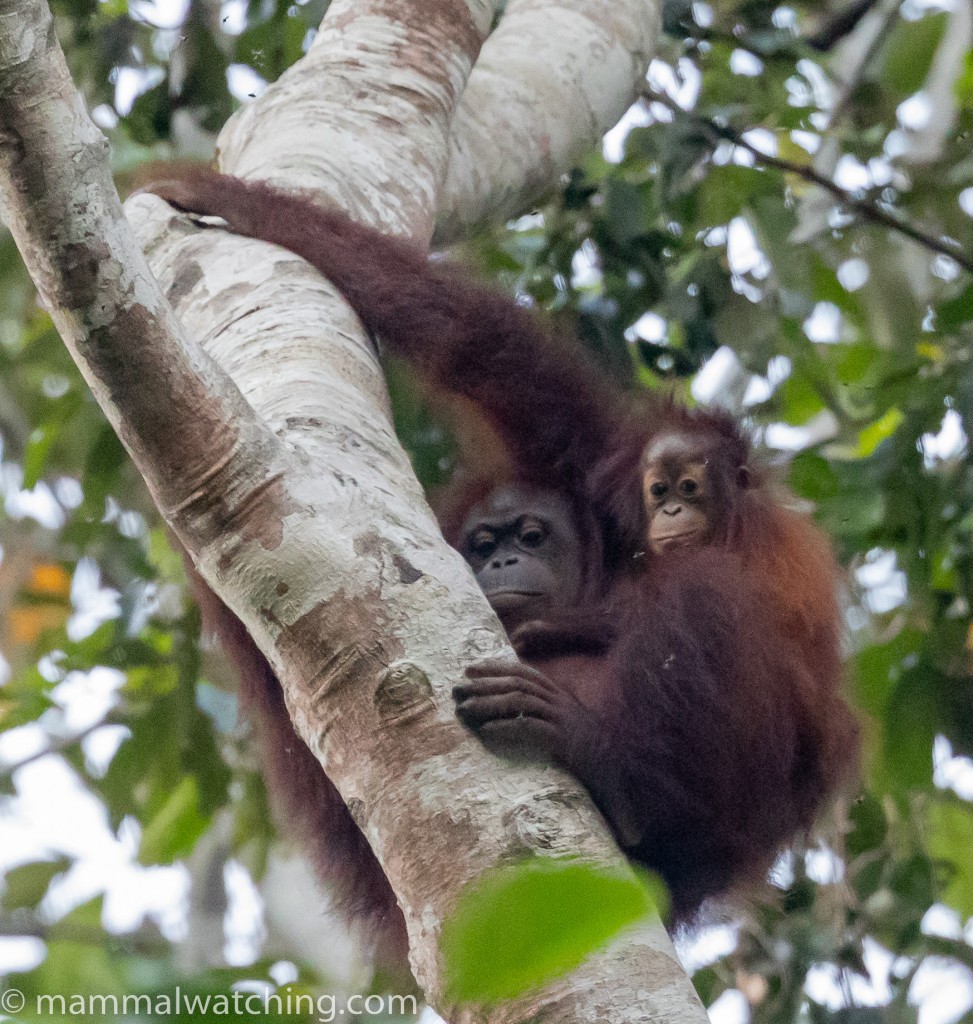
Bornean Orangutan (Pongo pygmaeus)
Bornean Orangutan (Pongo pygmaeus): easier to see than usual in Deramakot, we counted 10 during our first morning drive.
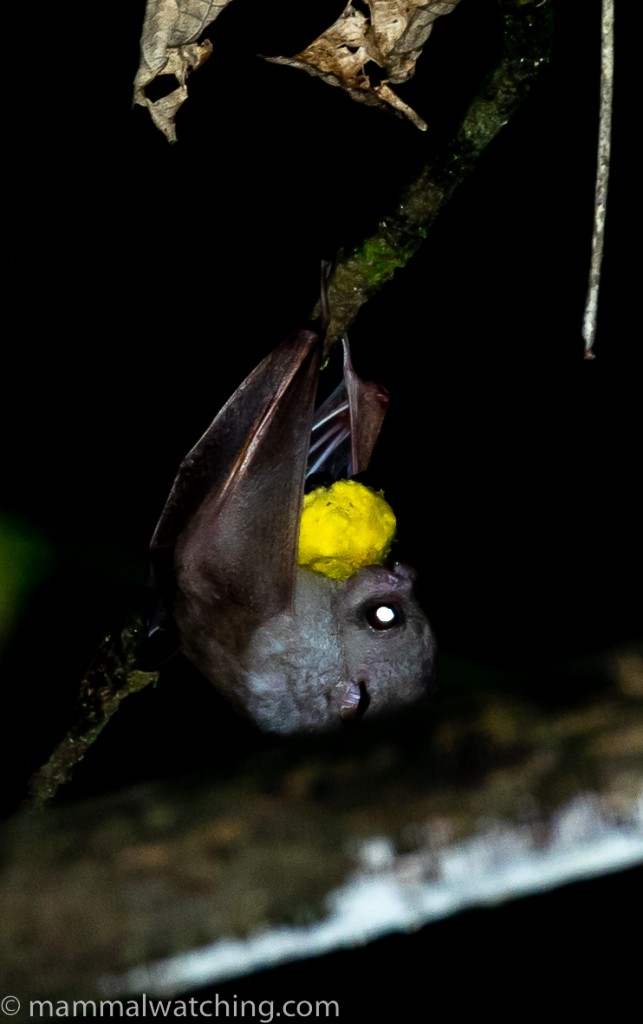
White-collared Fruit Bat (Megaerops albicollis)
White-collared Fruit Bat (Megaerops albicollis): this small fruit bats was seen well in Dermakot. The species was once thought to be very rare on Borneo. Lifer.
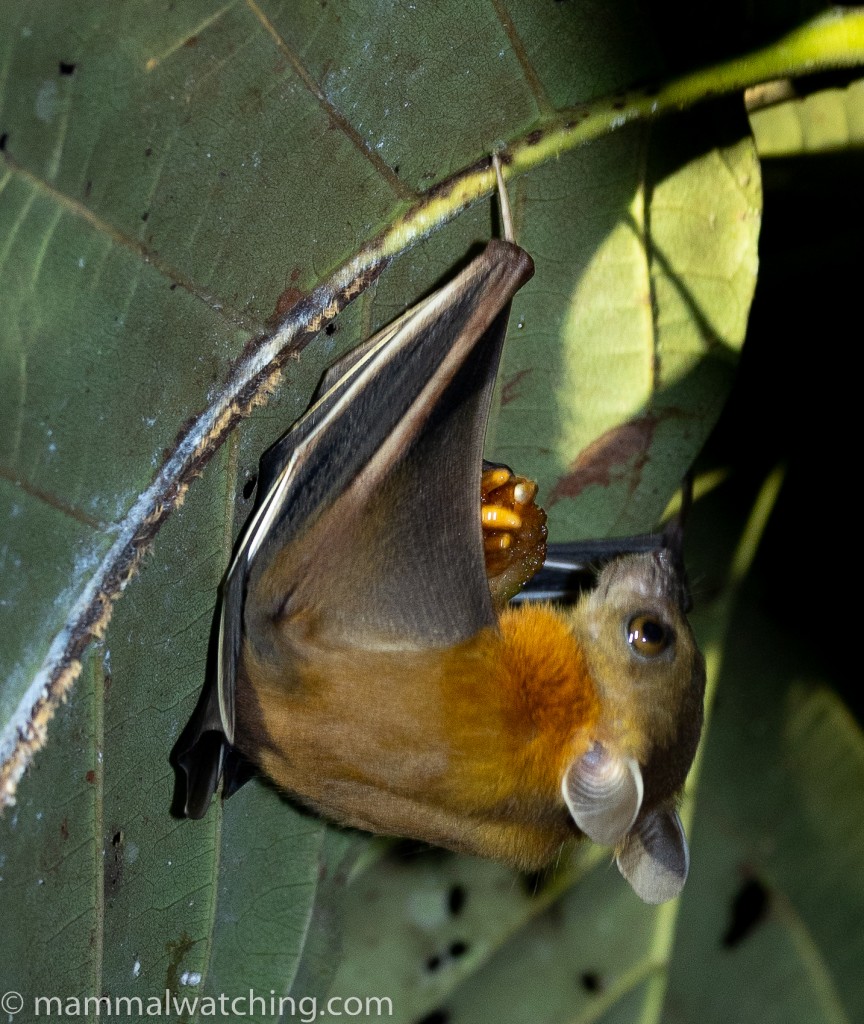
Short-nosed Fruit Bat (Cynopterus sp.)
Short-nosed Fruit Bat (Cynopterus brachyotis/minutus): we saw several Short-nosed Fruit Bats in Deramakot and another in Sayap. I know of know reliable way to differentiate C. brachyotis from the slightly smaller C. minutus if you don’t have them in the hand (but if anyone can tell me what this species in the photo is please do).
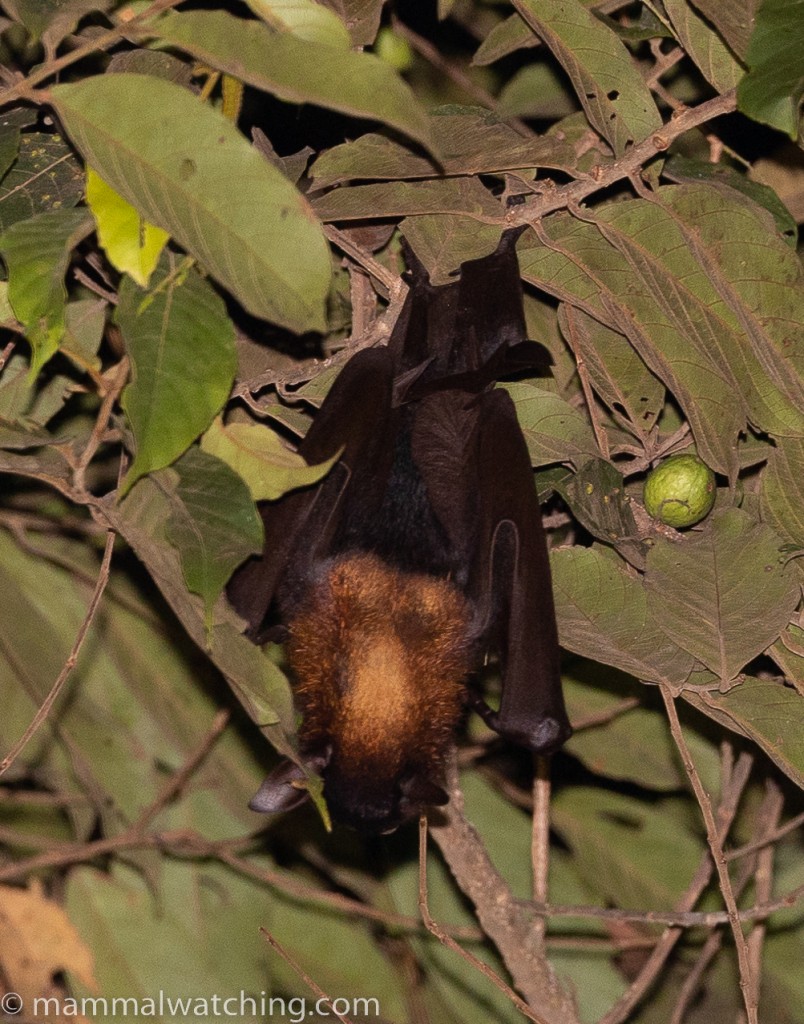
Large Flying-fox (Pteropus vampyrus)
Large Flying-fox (Pteropus vampyrus): frequent in Deramakot.
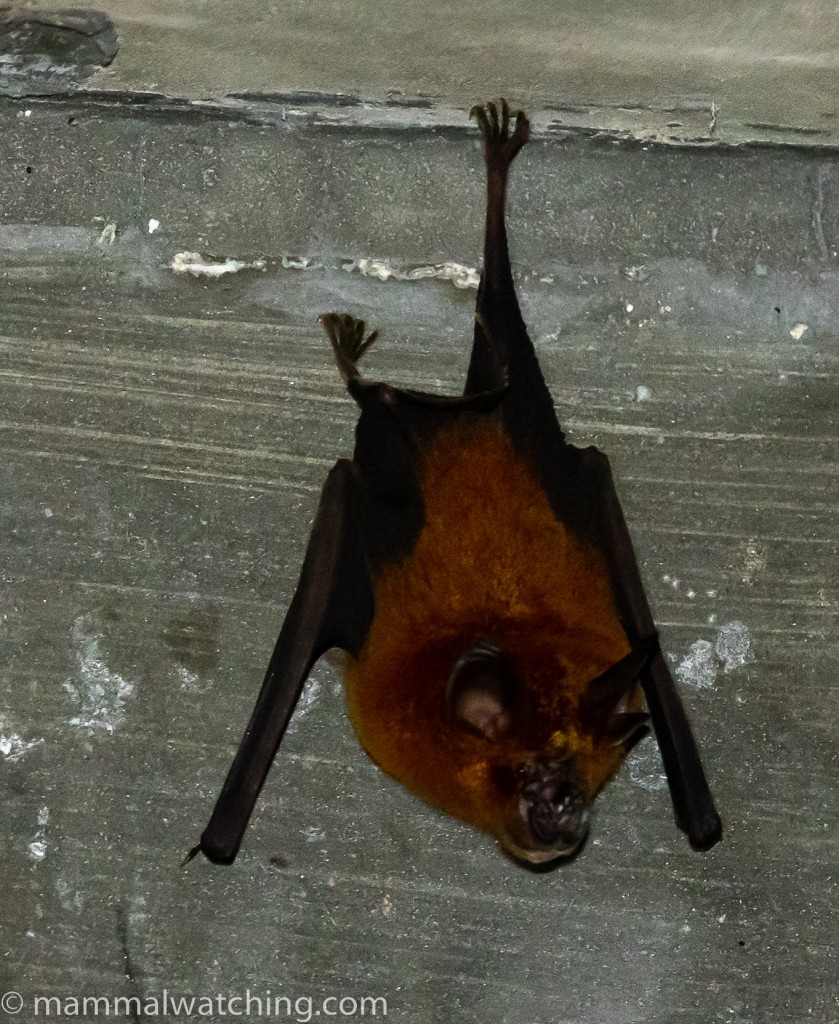
Accuminate Horsheshoe Bat (Rhinolophus accuminatus)
Accuminate Horsheshoe Bat (Rhinolophus accuminatus): a dozen or so horseshoe bats were roosting underneath the Deramakot canteen. Likely this species based on color, roosting habits and profile of the sella below.
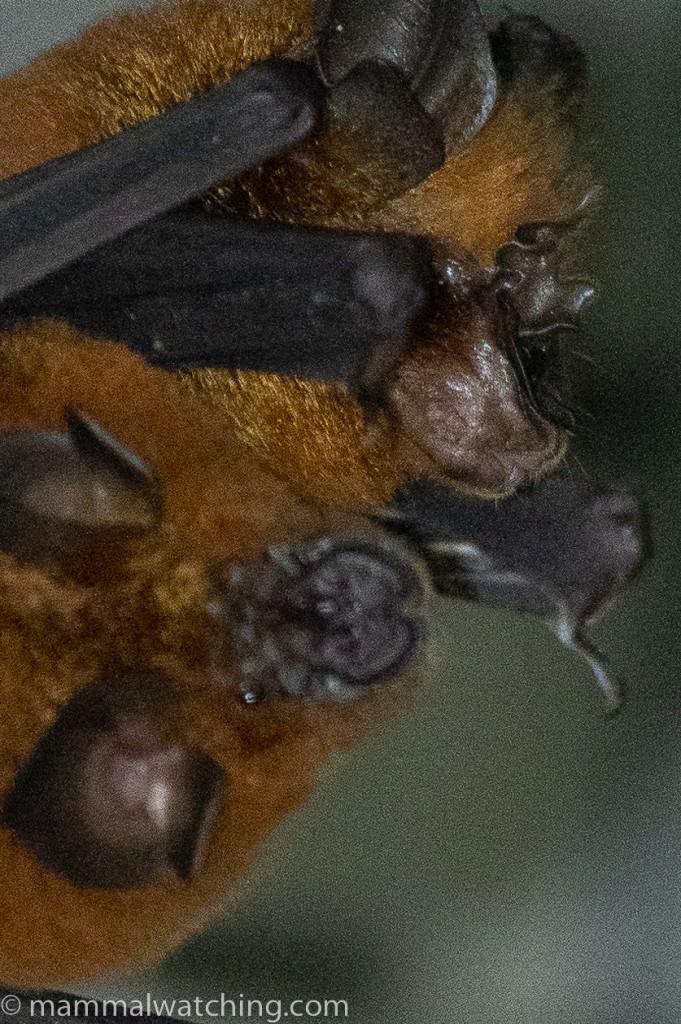
Accuminate Horsheshoe Bat (Rhinolophus accuminatus)
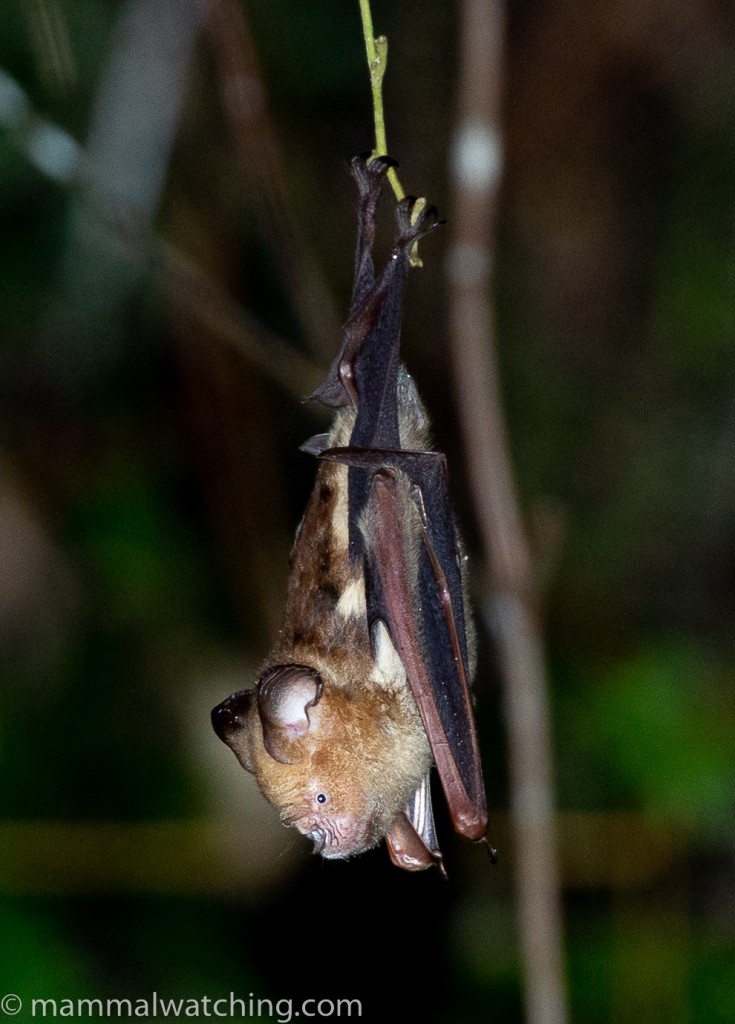
Diadem Leaf-nosed Bat (Hipposideros diadema)
Diadem Leaf-nosed Bat (Hipposideros diadema): Mike spotted a few of these large, spectacular bats hanging from twigs which they use as night-time hunting perches in Deramakot.
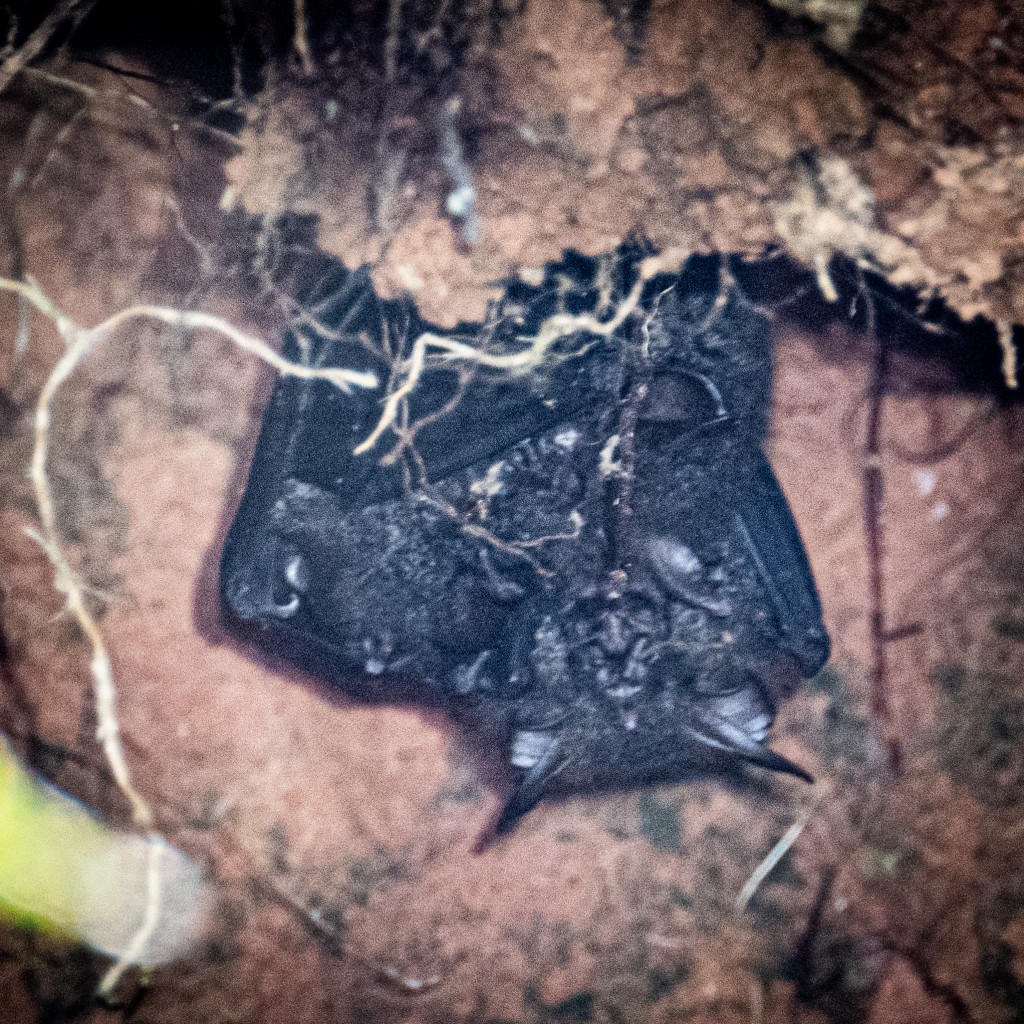
Andersen’s Woolly Horseshoe Bat (Rhinolophus foetidus). Photo Charles Hood.
Andersen’s Woolly Horseshoe Bat (Rhinolophus foetidus): my thermal scope tracked down three of these roosting under a dirt overhang along the road near to the Kinabalu visitor centre. Their large size and grey wooly fur make them easy to identify. This is a recent split from the Greater Woolly Horseshoe Bat. Lifer.
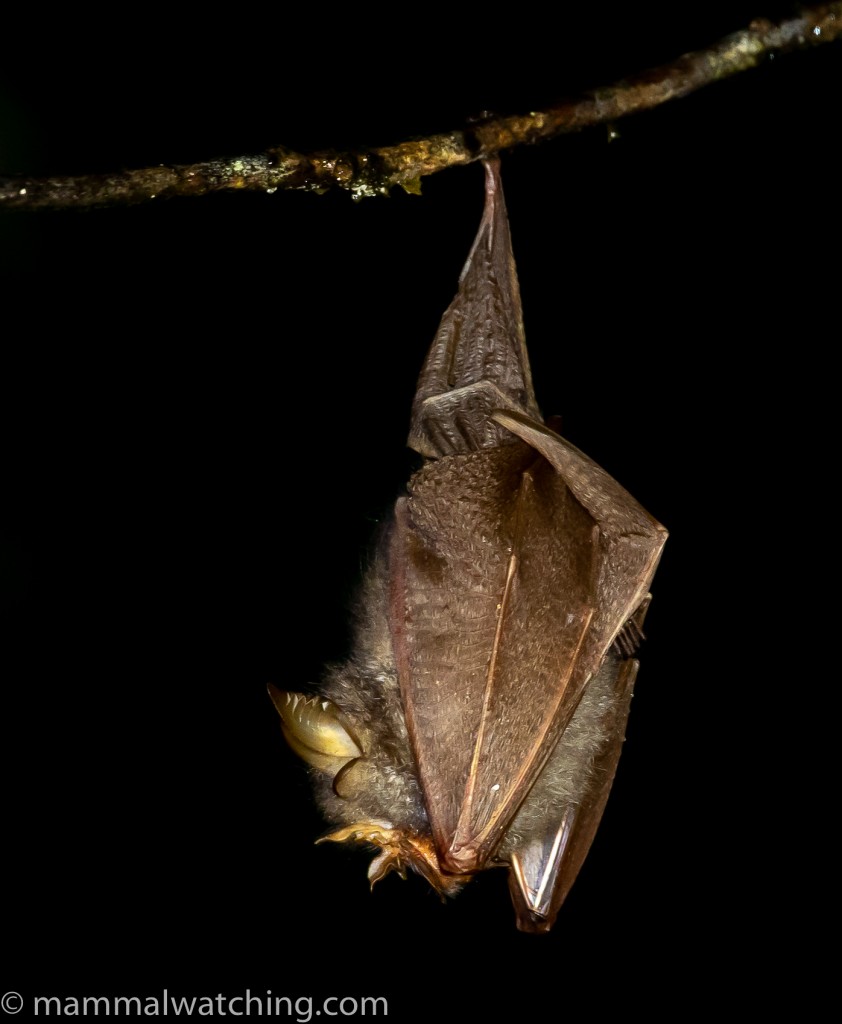
Trefoil Horseshoe Bat (Rhinolophus trifoliatus)
Trefoil Horseshoe Bat (Rhinolophus trifoliatus): Mike spotted a few of these hanging from twigs during Deramakot night drives. Their woolly fur and yellow ears and noseleaf mean they are unmistakeable.
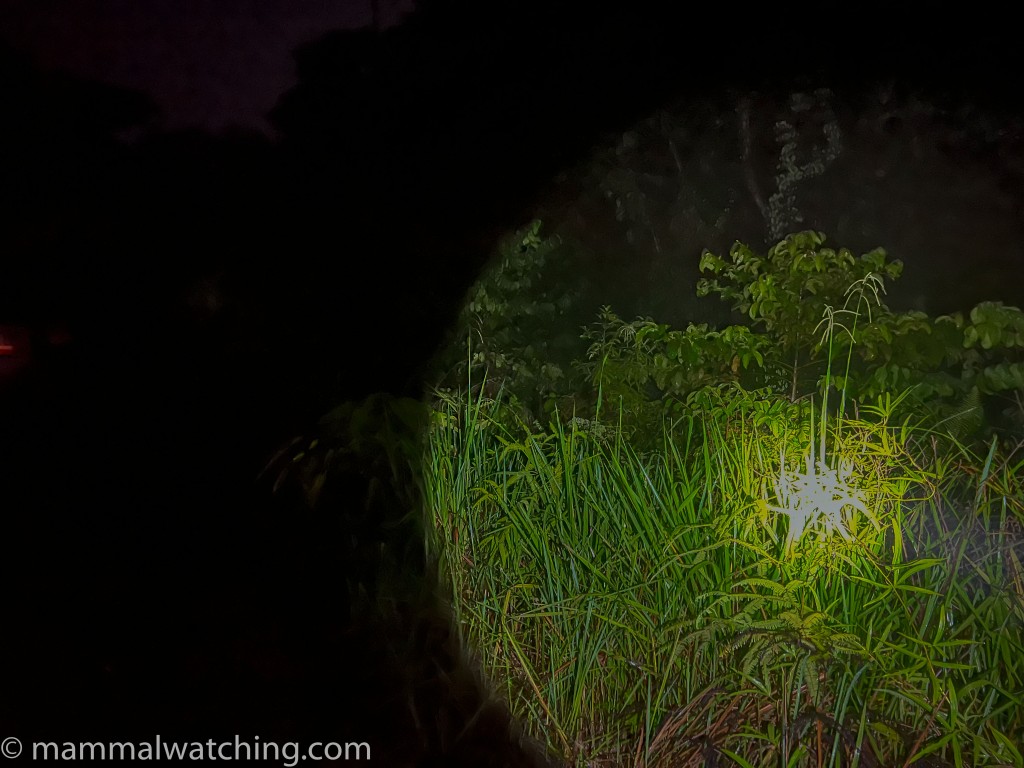
A Bay Cat ‘s last known whereabouts.
Borneo Bay Cat (Catopuma badia): the biggest surprise of the trip was watching a Bay Cat cross the road after heavy rain at 11pm in Deramakot. We watched the animal, through binoculars, trot across the road about 10km out of camp towards the main gate. It disappeard into the long grass 10 minutes before this photo was taken. Ian Thompson’s report has more details. Lifer
Sunda Leopard Cat (Prionailurus javanensis): several of these small cats along the edge of the Deramakot roads.
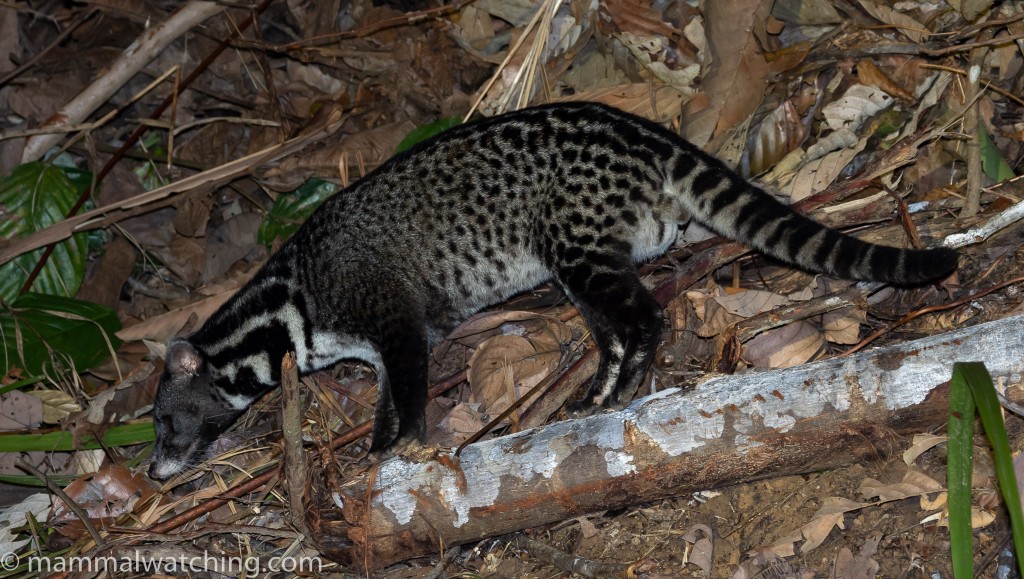
Malay Civet (Viverra tangalunga)
Malay Civet (Viverra tangalunga): most nights in Deramakot. This one seemed oblivious to the flashlight’s beam.
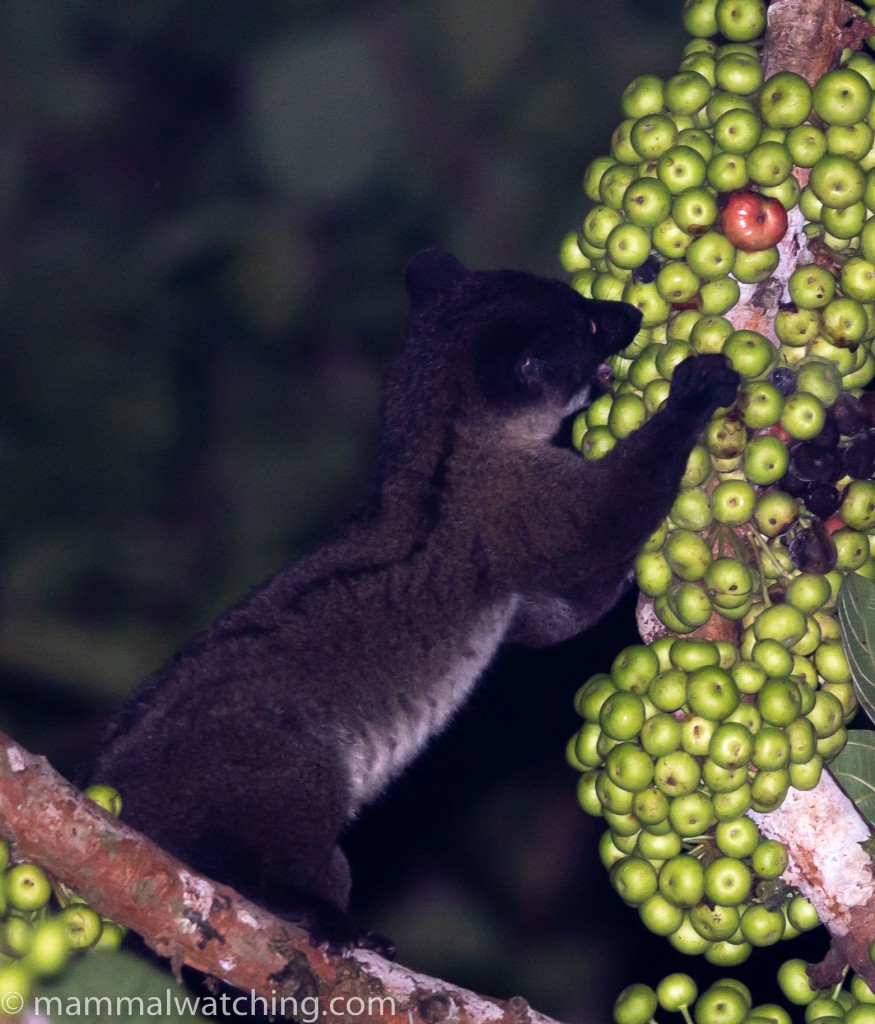
Bornean Striped Palm Civet (Arctogalidia stigmatica)
Bornean Striped Palm Civet (Arctogalidia stigmatica): this Bornean split from the Small-toothed Palm Civet was seen every night in Deramakot. They are more arboreal than the Bornean Palm Civet.
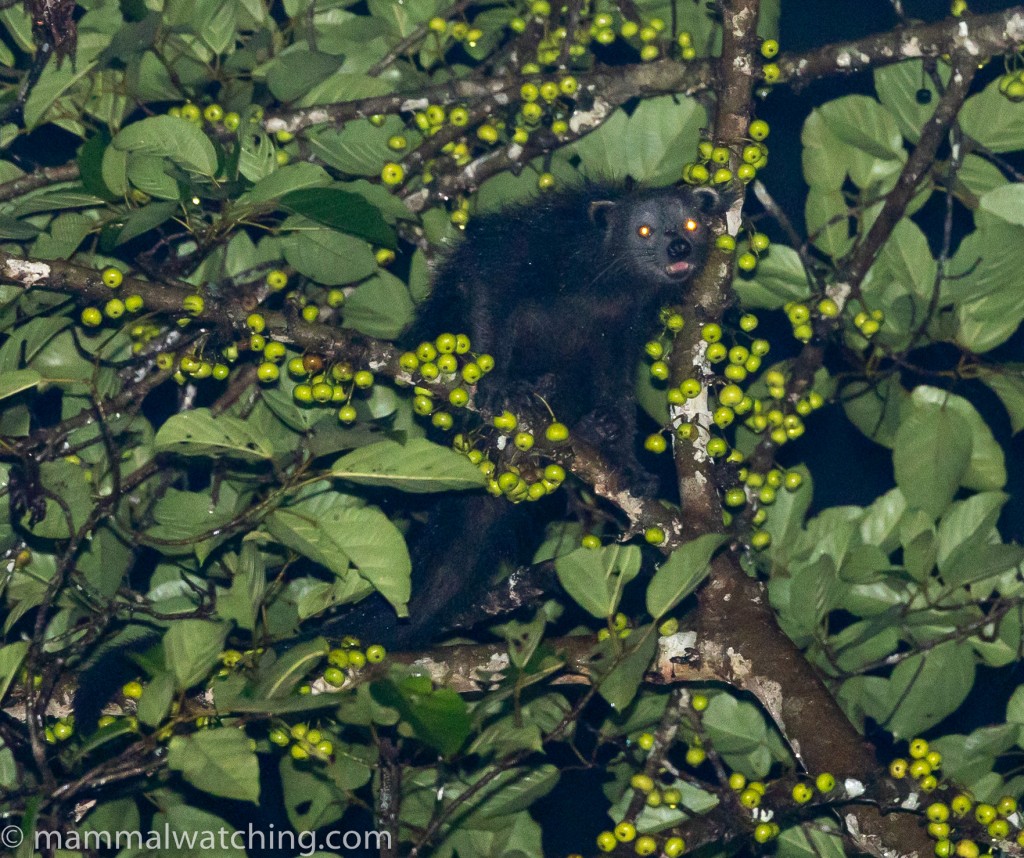
Binturong (Arctictis binturong)
Binturong (Arctictis binturong): we had Binturongs, or Bearcats, on 3 of our 8 nights in Deramakot. Always in a fruiting tree.
Bornean Palm Civet (Paradoxurus philippinensis): almost every night in Deramakot, usually on the ground.
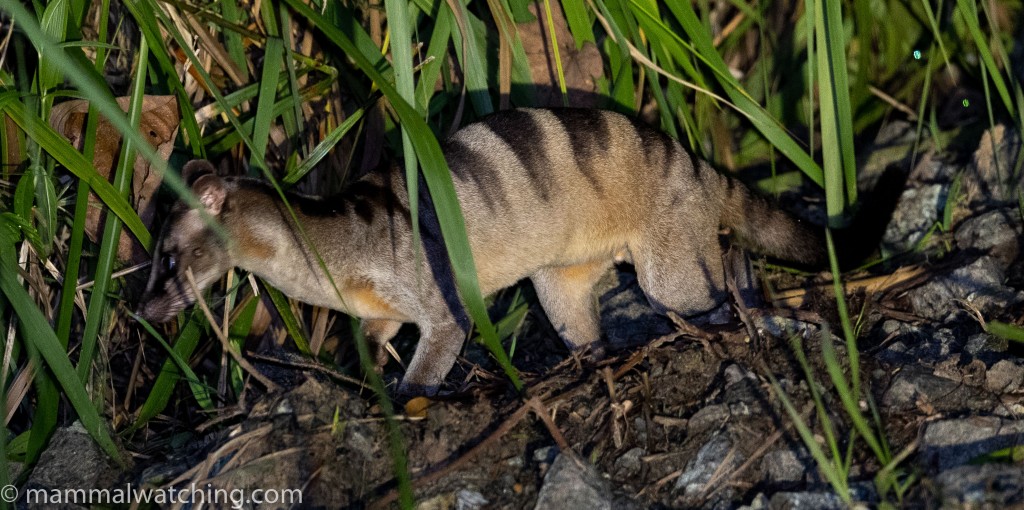
Banded Civet (Hemigalus derbyanus)
Banded Civet (Hemigalus derbyanus): Dermakot is one of the best places in the world to see this gorgeous civet. We saw them on 3 of our 8 nights. One, seen minutes before we saw the Bay Cat, was climbing down from a tree, the first time Mike had even seen one off the ground.
Sun Bear (Helarctos malayanus): brief but clear views of two bears in different areas, both not long after dusk. One ws running up a bank the other shimmying down a tree. The highlights of my trip (sorry Bay Cat): my final bear and my third most wanted mammal in the world. Lifer.
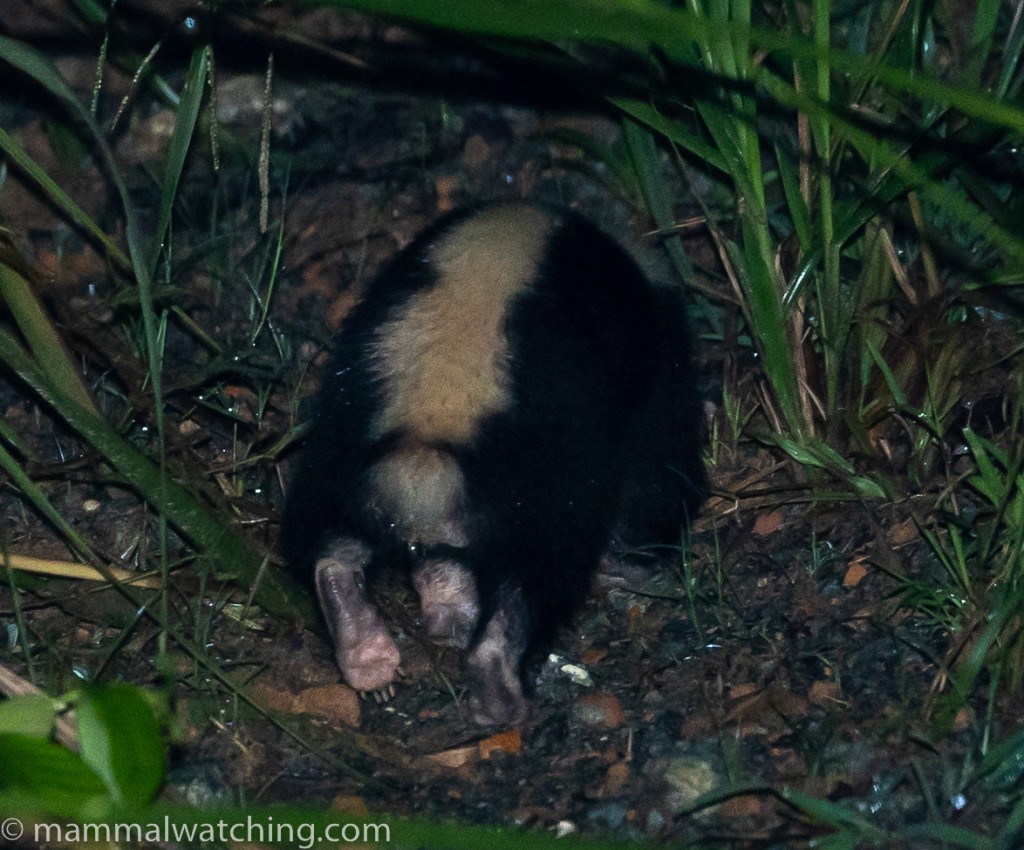
Sunda Stink-badger (Mydaus javanensis)
Sunda Stink-badger (Mydaus javanensis): we followed one in Deramakot walking along the road for a hundred metres or so.
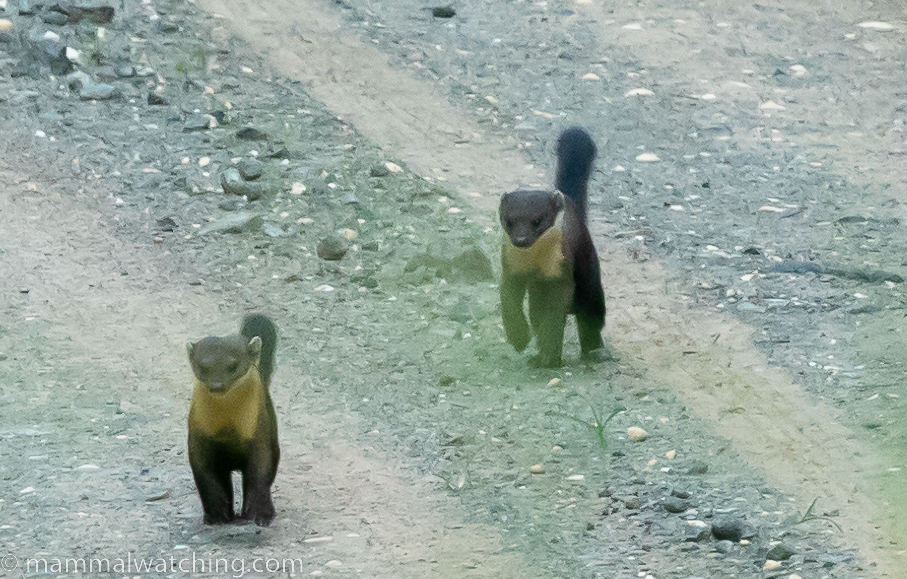
Yellow-throated Marten (Martes flavigula)
Yellow-throated Marten (Martes flavigula): we met a pair running along the road towards us at around 7am. We were on foot about 2km from the accommodation.
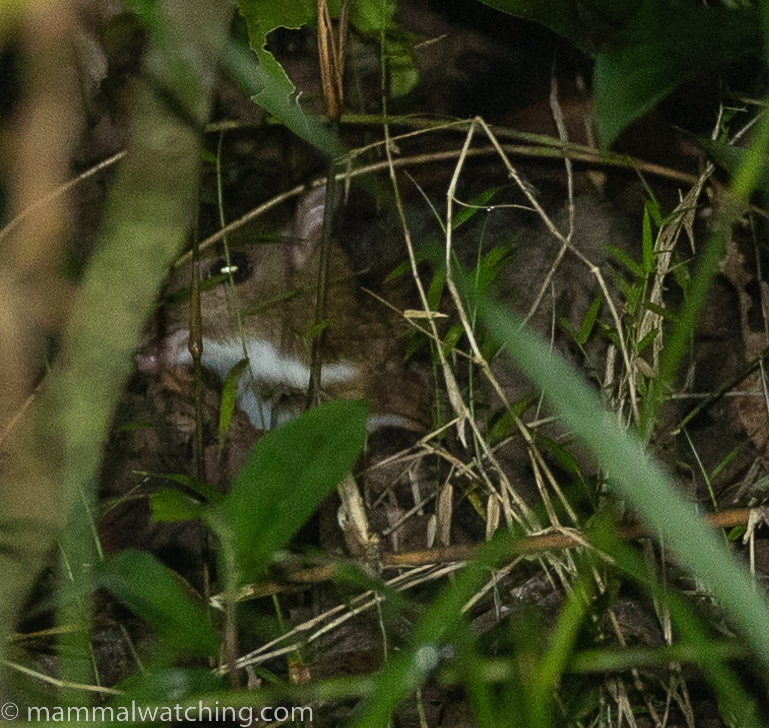
Greater Oriental Chevrotain (Tragulus napu)
Greater Oriental Chevrotain (Tragulus napu): one in Deramkot frozen just off the road, and another after dark during the drive in.
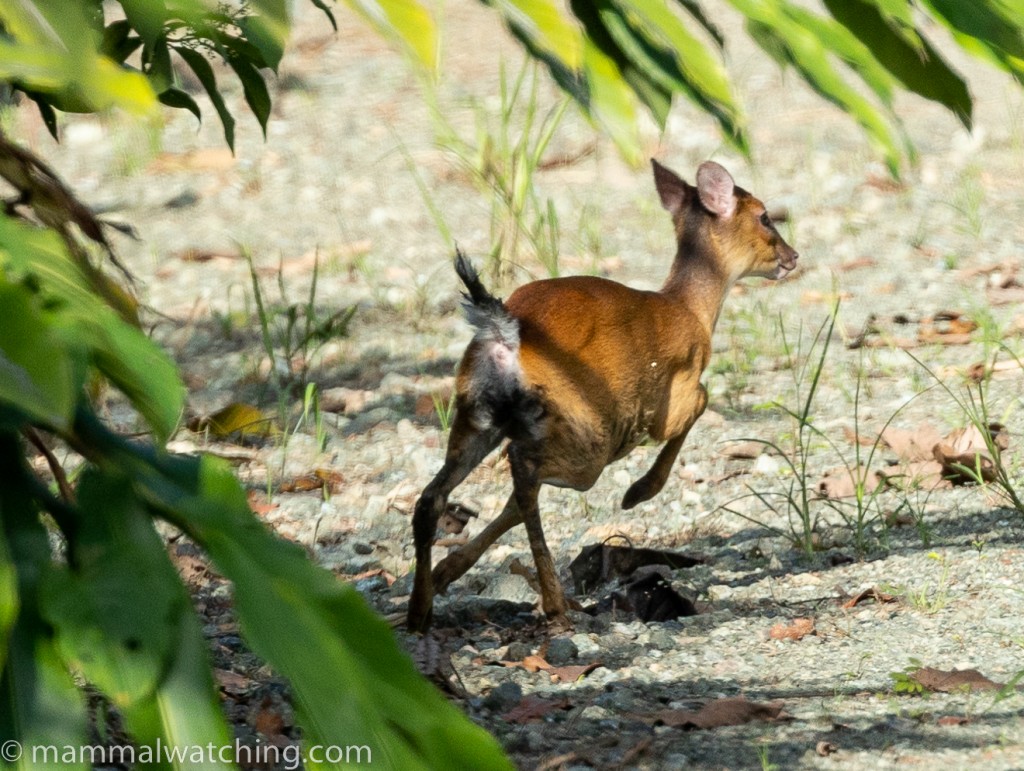
Bornean Yellow Muntjac (Muntiacus atherodes)
Bornean Yellow Muntjac (Muntiacus atherodes): one in Deramakot at the side of the road in the late afternoon. Though presumably fairly common in the reserve they are seldom spotted in the open.
Sambar (Rusa unicolor): on four Deramakot nights, always close to the accommodation.
Total 52 species with 13 lifers
Other species
I glimpsed a tree shrew in Deramakot but have no idea which species. Ian Thompson saw another on Sayap which was possibly a Lesser Treeshrew. Charles Hood saw a shrew, possibly a Bornean Shrew, in the botanic gardens on Mount Kinabalu.
Stuff We Missed
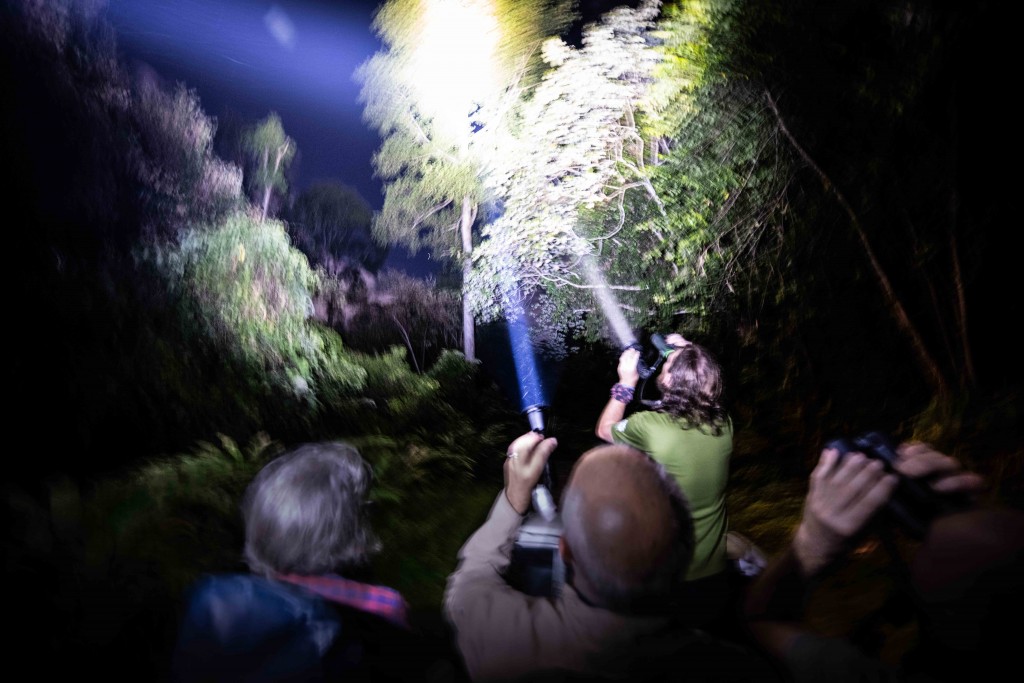
This trip was built around 6 target species: Sun Bear, Clouded Leopard, Marbled Cat, Otter Civet, Banded Linsang and Tufted Ground Squirrel. We only saw only the Sun Bear. Though in truth if we had thought there was even a remote chance of seeing a Bay Cat then that would have been on our target list too.
Clouded Leopard and Marbled Cat are still around Deramakot. Both were seen just before we arrived and soon after we left. Mike does not believe there is any strategy you can use to maximise your chances of seeing these species other than spending time on the Deramakot roads and hoping for the best. That sounds about right to me. There are chances for both species in the Danum or Tabin for sure, but are the chances any better?
Mike tried very hard to find us an Otter Civet. There are several good spots in Deramakot where he seems them quite often – small ponds or drainage ditches along the roadside – and if we had had more rain I suspect we might have gotten lucky.
I imagine Banded Linsang are still on Kinabalu but now that the road is closed to private vehicles I suspect they are going to be much more difficult to spot if mammalwatching has to be done on foot.
Seeing a Tufted Ground Squirrel in Sayap in two days was always a long shot. They are not abundant. Having it as a target species has brought it more into focus for future trips at least.
Most of us were also very keen to see a Sunda Pangolin, which are seen occasionally in Deramakot. One group saw one while we were there (during an afternoon drive into the park). And Ian and I tried to see Tarsiers several times along the Ecology Trail in Deramakot and briefly along a trail in Sayap where they have been reported. Night walks at the Sepilok Orangutan Rehabilitation Centre might be a reliable way to see this species.
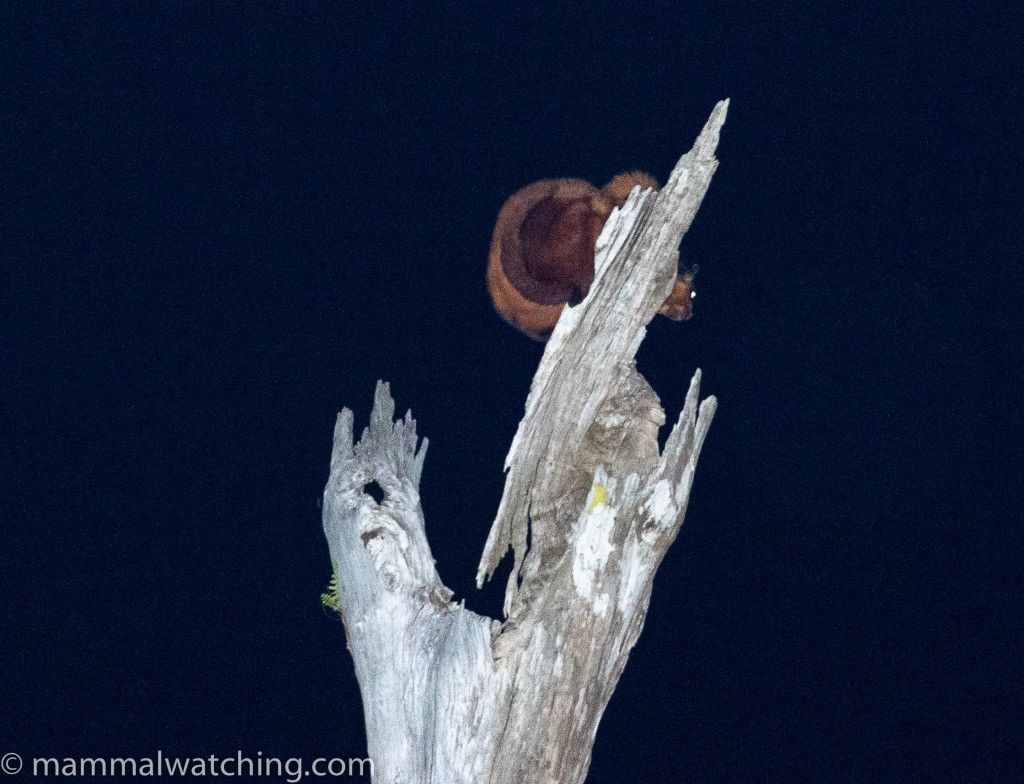
Thomas’s Flying Squirrel (Aeromys thomasi), Deramakot.
Thank you
A huge thanks to Mike Gordon for all his hard work and good humour and to our tireless Deramakot team: our driver Andy and the talented kitchen staff. Thanks also to Tom and Nick from AA Borneo for setting it all up and to my fellow mammalwatchers for their spotting skills and good company.
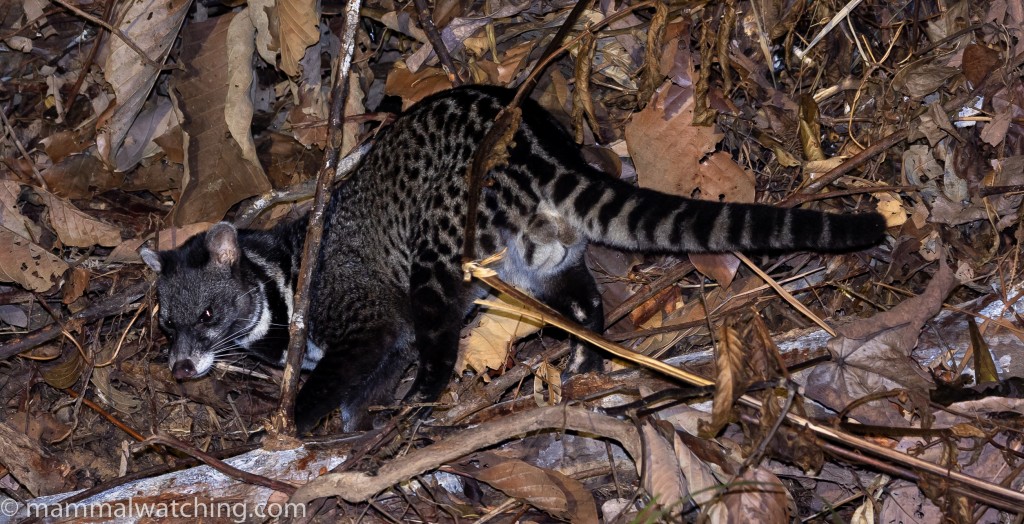
Malay Civet (Viverra tangalunga)
13 Comments
-
-
-
tomeslice
Such an awesome trip report – congrats on the ultra-mega-rare Bay cat!!
Not that I keep tabs on people… but if my recollection serves me right, I’m pretty sure Phil Telfer has now almost cleaned up Borneo except for some rare endemics..? And he’s the only “Westerner” who has now seen all of Borneo’s 5 cat species! Along with pangolins, sun bears, tarsiers… that’s not to say that I’m, urghhhh, *jealous* of Phil Telfer.. (#totallyjealous; #totallykeeptabsonpeople) lol..
Anyway – great stuff – very happy for you guys!
-
Phil Telfer
Hey Tomer, Nice comment but missing one big part of that. I still haven’t seen a Marbled Cat.
Aside from that i’d like to see a Linsang and also haven’t seen a Thick-Spined Porcupine. Probably have to retire from Borneo if i get those.
Mike and Deramakot have been pretty lucky for me but i have put in 28 nights there now.
Good to know you’re keeping tabs BTW.-
tomeslice
Hey Phil,
No worries, I’m still very jealous! Lol.
I do have Marbled cat but I’m missing flat-headed, clouded leopard and of course bay cat. So I need to have another few long trips there.. at least.You should also try for hose’s civet and of course tufted ground squirrel!
I’m guessing Tawau for Hose’s civet? But I’d have to consult with Mike and Shavez. Next time!
-
-
Sebastian Kennerknecht
Great trip and huge congrats on the bay cat! (And the sun bear, i guess, haha). Great to meet in person Jon and the rest of the team!!
-
Jon Hall
-
-
Jens
Really great report and I am so happy that you saw a Bay cat (and a bit jealous as well) but sad that there you missed out on your targets. I have been to Deramakot 4 times and I thought as was one of the first ones there in 2016 when we had to bring everything with us. I still haven´t seen clouded leopards or Bay cats so I want to go back again later in the year. The question is always: how many days should I stay in Deramakot, should I stay days at Danum or Tabin? And most important am I going to spend even more days (I am lucky that I forgot how many days it is) in Deramakot without seeing clouded leopards yet another time?
-
Daan Drukker
Hi Jon, I’m struggeling to find characters for Sculptor Squirrel. Would you mind emailing me all your photos of that species? I wonder for example if your last photo in the series here isn’t a Jentink’s, with that white eyering and ear. Hopefully I will be well-prepared for my Borneo trip this August!
-
Jon Hall
Sure Daan – I will send you some pictures if I see any that are useful. But most of them are very similar to these. These latter pics were very distant and in quite poor light. It was the behaviour of the squirrels – feeding underneath the leaves exactly as described in Quentin Phillipp’s book that convinced me of the ID. Not sure I would have been able to ID them as Sculptor Squirrels otherwise. The animals in front of our cabin – the first picture – were also at first light but much closer and the belly colour was distinctive. As you will discover, identifying some of the Bornean squirrels can bring people to the edge of a nervous breakdown!
-
Daan Drukker
Hi Jon, that would be great! So far the pictures I’ve seen look quite different from what is painted in the Phillipp’s, as they are depicted there with very broad white flank stripe and deep red belly (but I’ve never seen that combination on a photo). I’m looking forward toward that breakdown!
-
-
-
Jon Hall
Daan have you seen Borneomammals.online? It’s very useful for squirrels https://borneomammals.online/2018/10/27/jentinks-squirrel-kinabalu-park-hq/
-
Leave a Reply Cancel reply
You must be logged in to post a comment.



Alan Dahl
Sounds like a great trip Jon. Borneo never disappoints it seems. 13 lifers is tremendous considering that was your 4th trip. I bet there will be a 5th some day too.